La Sagrada Família - The Visit
last update: 20 Nov. 2019
Note: I will need to integrate a recent article "A Model Restoration", ACM Vo. 64, No.9 Sept. 2021
The full name is the Temple Expiatori de la Sagrada Família, where the sense of 'expiation' is, I presume, to expiate the sins of the world.

The construction was started in 1882 under the architect Francisco de Paula del Villar y Lozano (1828-1901), but was in 1883 handed over to Antoni Gaudí (1852-1926). It is Gaudí that was responsible for looking to combine Gothic and Art Nouveau styles. The building has had a chequered life, but it is hoped that it can be completed in 2026, for the centenary of Gaudí's death. The building is a UNESCO World Heritage Site and in 2010 was consecrated by the Pope as a minor basilica (one of 1,768 around the world).
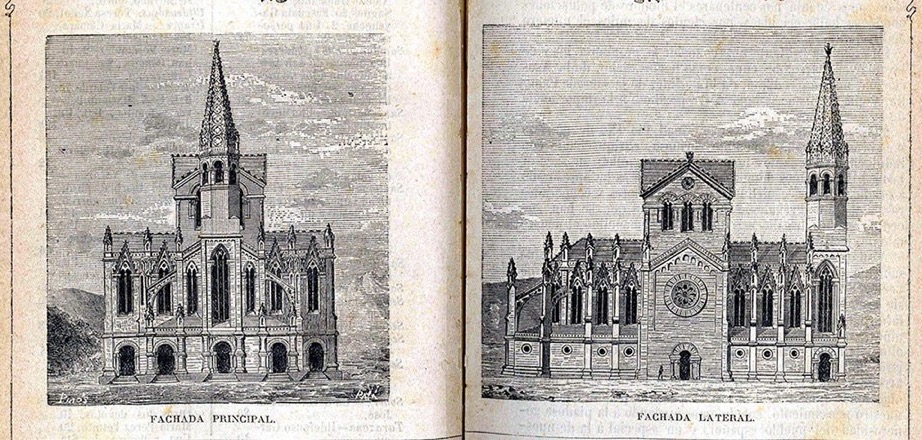
We can see above the church as planned by del Villar. Starting in 1883 Gaudí, aged thirty-one, had to abide by the basilica’s orientation and the work already done on the crypt by del Villar, but he nonetheless proposed a much more ambitious project.
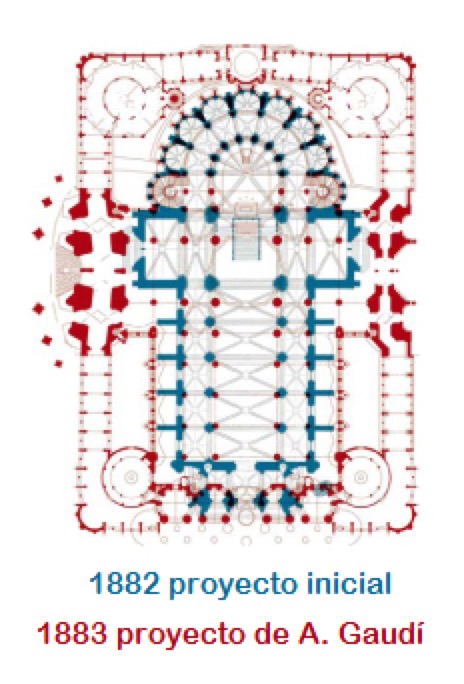
He conceived a temple with five naves, a crossing, an apse, a cloister-outer ambulatory, three façades and eighteen towers.
Something often forgotten is that Gaudí knew that he would not finished the basilica, and so he designed and built it in stages. He expected that future architects would continue and impose their style on each successive stage in its construction.
We also have to remember that the cost of the continued construction of the basilica is now almost entirely paid from ticket receipts. It is said that it is often still referred to as a temple because it has never received money from the government or the church.
There is a vast collection of texts describing La Sagrada Família, and the Wikipedia article is also an excellent starting point.
The visit
We had first visited Barcelona and La Sagrada Família in 1998, and I remember that the visit was quite quick because the interior was just a pile of scaffolding.

Now it was time to visit again La Sagrada Família in early July 2019, some 21 years later.
This time we booked our tickets on the basilica's official website. We booked the 'basic ticket' and fixed our entry time at 12:30. We immediately received our tickets in my iPhone Wallet, and an email message with some practical information and reminding us that we should be on time, etc.
We actually arrived early and found the exterior of the site completely surrounded by tourists. Walking round the site we noticed that the ticket office was closed, with the message that the days access had been sold out.
There are different access points, for groups, individuals and school groups. At any given time there was a 10-15 minute wait for access. The security guard at the entrance actually suggested we try the access reserved for guides, which also was used by those with mobility problems. We were able to slip in without too much hassle. I must admit that everyone was very friendly and helpful. For example, a lady with an electric wheelchair and her friend could not buy tickets but were only there for the day. The girl at the entrance gave them two free tickets and helped them through the entrance.
It was interesting to see that the crowds waiting to enter, once inside were quickly lost within the vast space of the basilica. Despite the fact that the site was 'full' and there were people everywhere, there was still plenty of space to sit, look around, and take in the full scope of the interior architecture.
One mistake we made was to buy a basic ticket, rather than one that included the visit to the roof. Still there is always a next time.
Another thing to watch out for is with the books in the shop. We bought a book and later found that many of the pages were stuck together, leaving nasty marks on pages when finally they were unstuck. So check the books immediately after buying, and if there are problems you can get them replaced.
What now?
I make no claim to original thought concerning the work of Gaudí or La Sagrada Família, but sitting inside the basilica there were three thoughts that did crossed my mind. My first thought concerned the structural engineering involved, and was Gaudí responsible for that? My second thought was more a question, was this basilica a modern day take on the Gothic cathedral? And my third thought was the well-visited question about the organic or vegetal inspiration that you see throughout the interior.

My decision was to look at the structural aspects of Gaudí's work, and the hope that one day we will return to see how things have progressed, and that I will then be able to take up one of the other questions mentioned above (or come up with a new question).
We have finally decided to split our visit report to La Sagrada Família in to two parts.
Firstly, the visit, which follows on the rest of this webpage.
And secondly, a separate webpage dedicated to 'Gaudí and Structural Engineering'.
Occasionally on my two webpages dedicated to La Sagrada Família I will duplicate this little list of infographics dedicated the church. Check out La Sagrada Família from Taylor's University and the Infographic La Sagrada Família by Jaime Serra of La Vanguardia.
The below description of our visit, is just that. I've only tried to include what we actually saw. There were plenty of seats around, either stone seats in the lateral aisles or wooden seats in the nave, so we had lots of time to relax and look around. But we did not see everything. Gaudí saw his building as a teaching tool, a 'Bible in stone'. So the problem is that every window, column, and decorative element refers to some holy 'mystery' or institution of the Catholic faith, and it's very difficult in one short visit to look at everything and totally impossible to understand even a part of what you see. So sitting there I wondered 'what does that mean?" or "why did Gaudí do that?", and I've tried to follow through and find answers to those few questions I asked myself.
So let's visit La Sagrada Família
The first problem is that we need to 'find our bearings'. We need a general map or site plan.

The plan above is a good starting point, as is the satellite image below. The 'Glory' façade is intended as the main entrance to the basilica when finished, however today (2019) the entrance for tourists is though the 'Nativity' façade. There is a metro station but we were dropped off by our taxi at the South corner in front of the 'Escoles de Gaudí' (there is also a taxi rank near the 'Botiga'). We had pre-booked tickets for 12:30 so we had time to stroll around the external perimeter of the site. As we walked along the back of the basilica we saw the ticket office near the West corner with 'Carrer de Provença' and 'Carrer de Sardenya'. The sign clearly said it was closed because the basilica was already fully-booked for that day.

Below we have a close-up of the front entrance, where there were several entry points. The main entrance is in front of the stairs on the right, and there is an entrance for groups in front on the stairs on the left. We can see the shop on the left-hand corner. We arrived slightly early and the guard kindly suggested we try the entrance further along the street, i.e. where there is a small white roof overhanging the pavement. This entrance is for people with mobility problems, and for small groups led by official guides. We waited our turn, passed through the security portal and bag scanning area, and went up to the first level in front of the 'Nativity' façade.
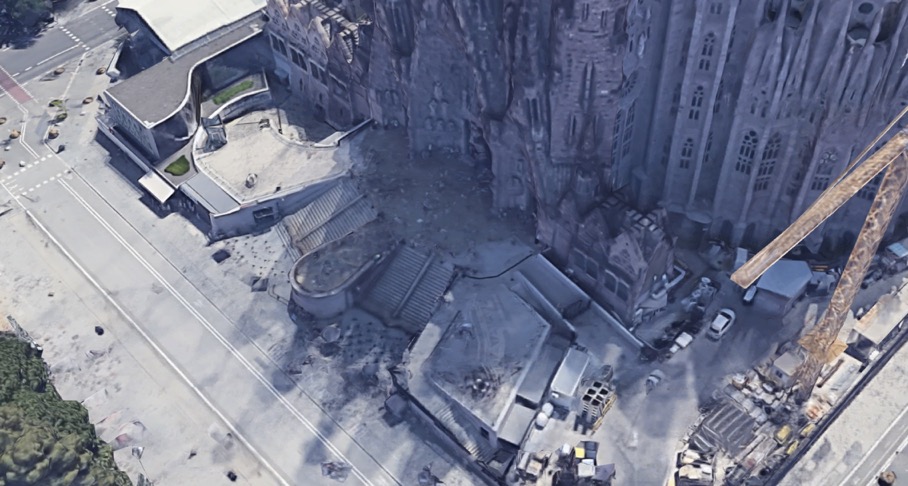
According to all the books and plans the intended main entrance is through the 'Glory' façade. On the plans we see a majestic terrace and set of stairs passing over Carrer de Mallorca. The problem I see is that those main stairs are situated where there are now several apartment buildings, and I don't see how they are going to knock them down, etc.

We are going to first look at the 'Nativity' façade, but it is useful to get an idea about how the interior is arranged. Above we can see that we are at the 'Nativity' entrance (no. 3 'Fachada del Nacimiento'). The general sense of the visit is to enter the right transept and to walk clockwise, leaving through the 'Passion' entrance (no. 2 'Fachada del Pasión') on the far side. Then, still within the walled site, you walk anti-clockwise back around the exterior, past the 'Glory' façade (no. 1 'Fachada del Gloria'), back to the entrance area, and then exit through the shop.
An additional point worth noting is that the high altar ('altar mayor') is situated in the apse (no. 7), and under the central dome ('cúpola central'). We can also see two sacristies (no. 11), but in fact at this moment, and as shown on the satellite image, the one on the right has not yet been built. Now let us look carefully at no. 5 the 'Crucero', the central part of the transept, highlighted in a light sandy colour. Above this in the centre there is the Tower of Jesus Christ, and sitting in each corner of that same coloured patch sits the four Towers of the four Evangelists (these are presently under construction).
Why three façades? Each façade has a meaning. The Nativity façade was designed and partially built by Gaudí, and was completed in 1935. It is dedicated to the birth of Jesus Christ and faces the sunrise in the North-East (the dawn of life). The decorative elements relate to nature and the creation of life. The Passion façade is simpler and is dedicated to the suffering of Christ during the crucifixion. The façade faces the setting Sun, and several artists have collaborated to try to capture the sins of man. The Glory façade is the largest and is still under construction. It will be the main entrance to the basilica and is dedicated to the last judgement and to the glory of Christ.
The Nativity façade
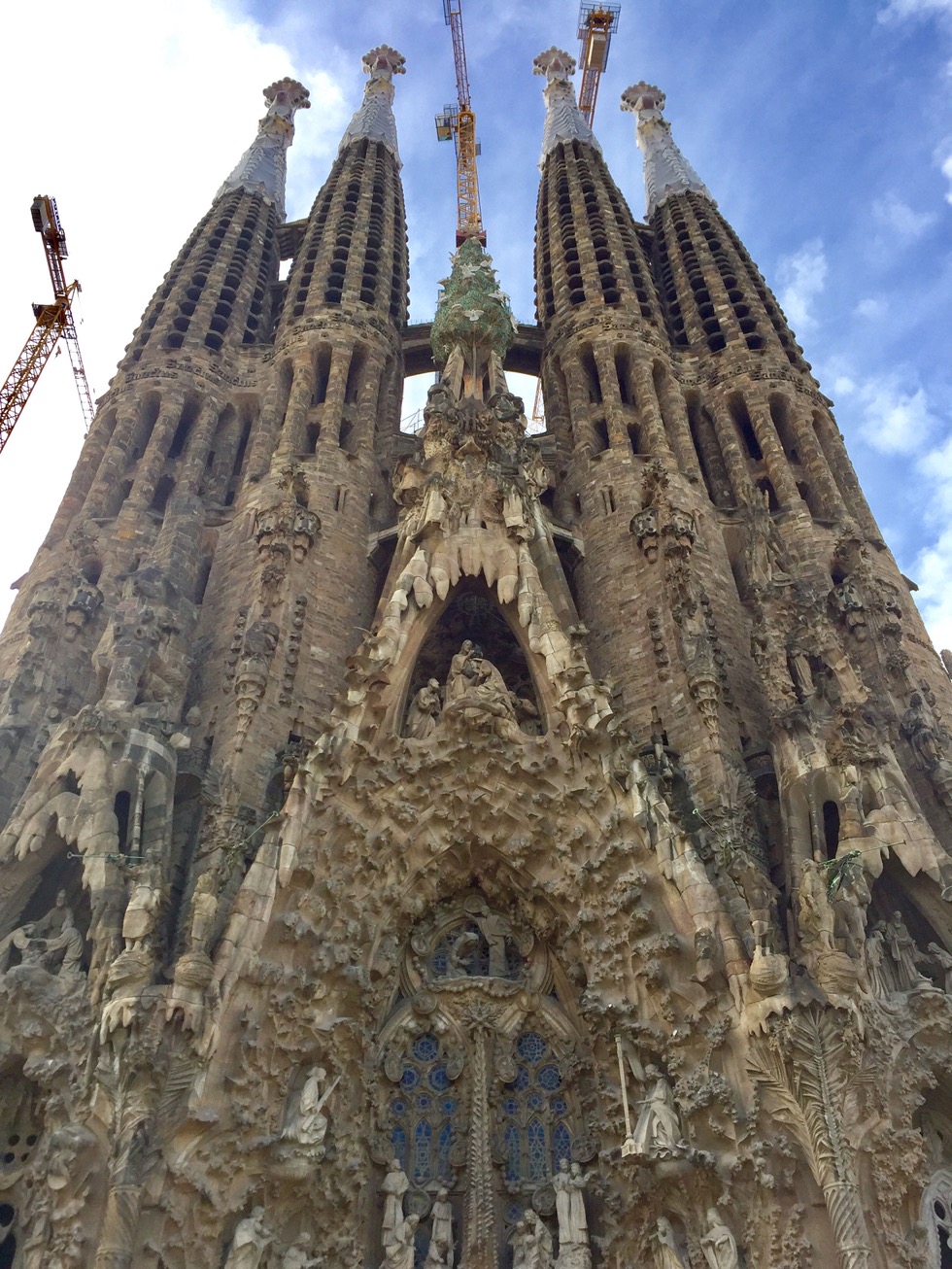
After undertaking the project, Gaudí finished the construction of the crypt in 1889, and at the same time started on the construction of the walls of the apse, which were finished in 1894.
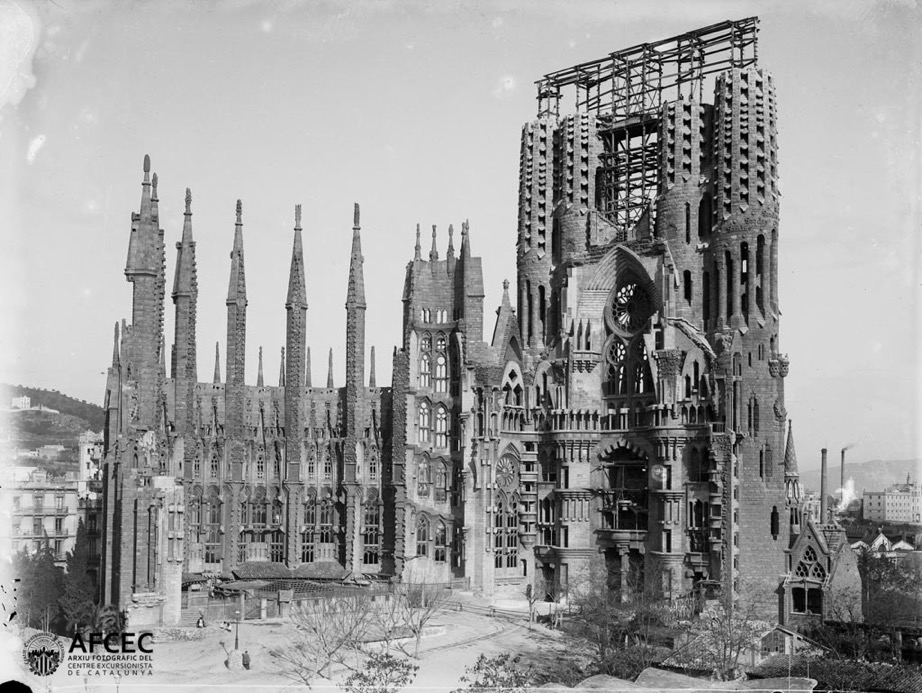
The work on the foundations of the Nativity facade began in 1892. In November of 1925 the first tower was finished, with a total height of 98 meters. The construction of the other towers was finally completed in 1930. The remaining parts, such as the cypress pinnacle (the Tree of Life) and the lanterns of the Hope and Faith portals, were finished before the Spanish Civil War in 1935.
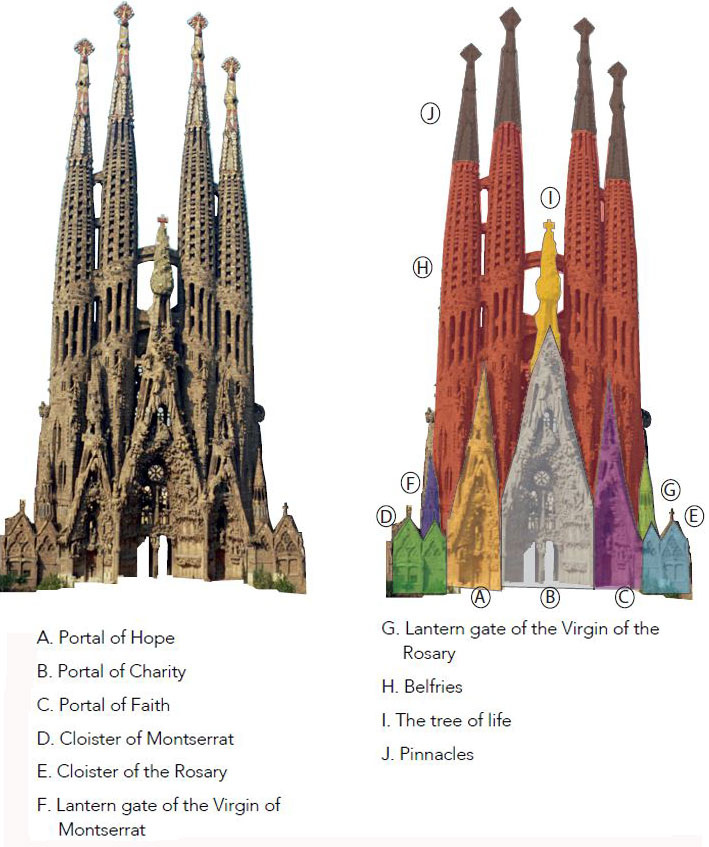
What we can see is that the façade is divided into several large parts, i.e. the three portals, the tree of life, and the four bell towers topped with pinnacles.
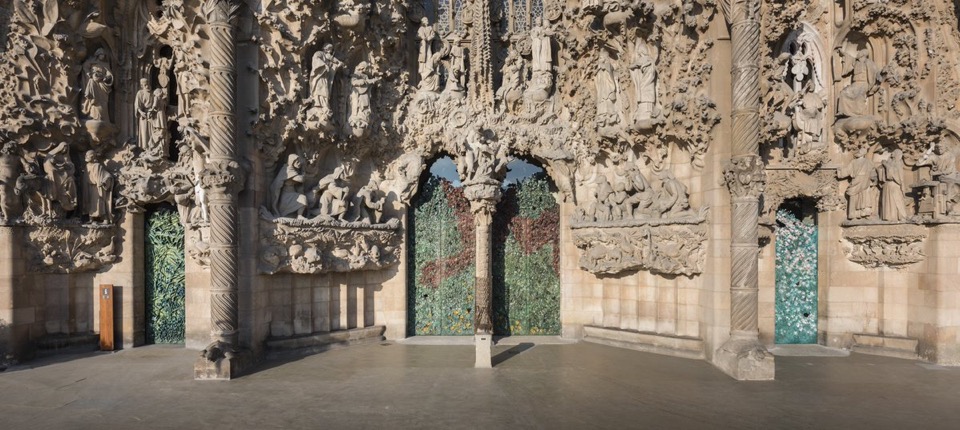
The Portico is made up of three entrances devoted to the three Christian theological virtues, Faith (on the right), Hope (on the left) and Charity (in the centre).
The façade is a profusion of sculptured figures, each part of a story. Franky I blanked out a bit at the total abundance of symbols. You either stand still and look up at the towers, or focus in on a little detail near at hand such as the vegetal motifs on one of the doors of the Charity entrance.
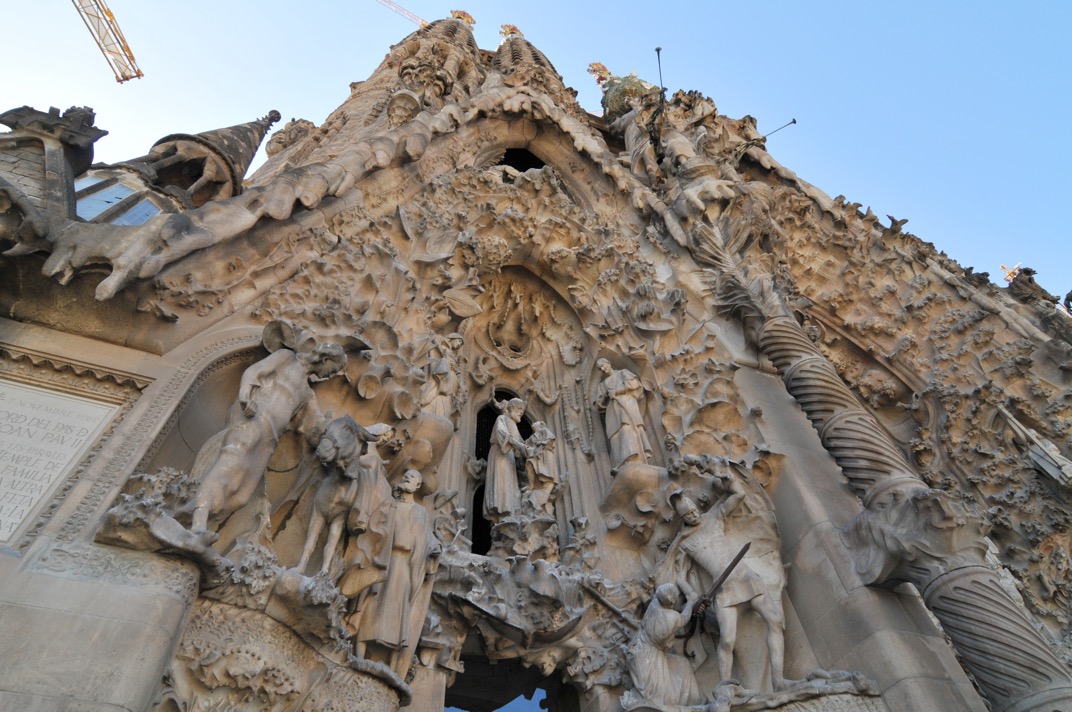

Brianna Campbell wrote up a nice descriptive of the Nativity and Passion façades, pinpointing key elements, but even she had to call the Nativity façade overwhelming, and said it all looked like a "great stone coral reef viewed from a distance". But she does a great job in breaking both façades into manageable chunks.
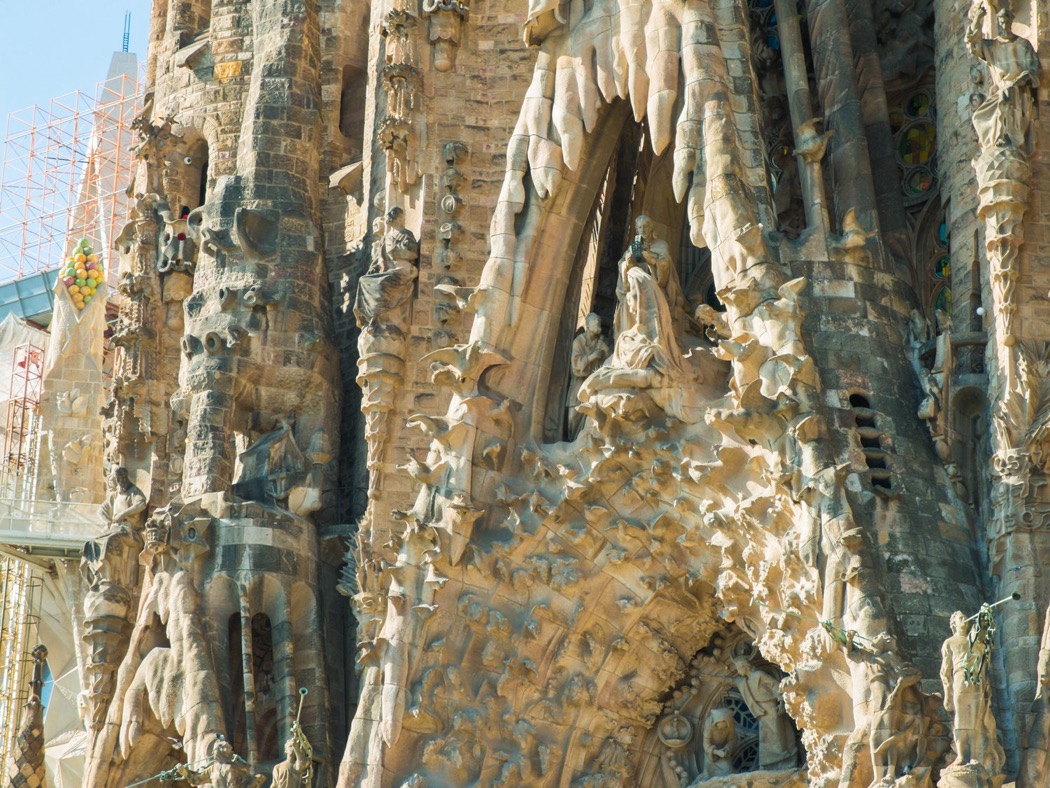
Laura Lytwyn also wrote up a nice blog on La Sagrada Família in which she noted that if we look carefully we can see 'snow' on the Nativity façade. In fact Gaudí equated the Nativity with Christmas and therefore included flowers, birds, and lots of soft round shapes. And you can also see drops and trickles of melting snow on the façade.
Laura's blog is certain a rich font of information, and she also went on to highlight another interesting feature of the basilica, the use of gargoyles, so-called grotesques or chimera used as spouts to drain water off the roof and away from the walls of buildings. The traditional interpretation was that grotesques represented evil fleeing head-down from the power of Jesus represented by the towers and pinnacles. Gaudí rehabilitated the grotesque by using animals considered as being of lower rank, i.e. reptiles and amphibians.


High up on the Nativity façade there is the 'Tree of Life' in the form of a green cypress tree. It sits on the top of the central portico dedicated to Charity. This central decorative element is full of symbolism. As Laura Lytwyn notes the cypress tree is a symbol of eternity in that it's an evergreen and never loses its leaves. You can just see that there are 21 white doves flying out of their nests, and on the top there is a Christmas Star in the form of a Greek cross. The Greek cross is made by combining the letters 'alpha' and 'omega', which mean the beginning and the end. Atop the cross is the last white dove, its wings spread wide, resembling the shape of Jesus on the cross.

Two ladders are placed below the tree, representing our mortal desire to reach eternal life. Below the tree there is a pelican perched, her beak angled down towards two baby birds, ready to be fed. The pelican was once believed to be a symbol of the Eucharist as in ancient times people thought the pelican opened its chest to feed its young, just like Christ offered up his own body to feed his disciples. Hidden beneath the young pelicans there is a brightly coloured egg, adorned with red and yellow glass. The egg is thought to represent either the birth of the universe or the resurrection of Jesus.
Below the tree we have a group of angels burning incense inside old vessels called 'censers'. Burning incense in the church is an ancient tradition which is thought to represent the prayers of the faithful rising to heaven. The pinnacle's stonework is covered in little bubbles, thought to represent the incense floating up towards the sky. It’s important to note that the angels here were actually sculpted by Gaudí himself.
On a more prosaic level, in October 2010, a tunnel-boring machine dug through the soil layers only 4 metres away from where La Sagrada Família’s principal facades foundation lies (see report here). It was envisaged that a 'settlement' of up to 22 mm could occur due to the construction of the AVE line, but to date there has been no reported damage to La Sagrada Família.

On the other hand, since the construction of the façade a considerable number of cracks have appeared, and have been repaired. These cracks are due to cracking in the interior walls. Below we can see just a few of the many repairs made to the façade and supporting walls.

The Nativity façade ('Façana del Naixement' in Catalan) is the only part of the church actually built by Gaudí himself.
Bell towers
When you look up at the Nativity façade you can just about make out the four bell towers, the two inner towers are 107 metres high, and the outer two are 98 metres high. From a distance you get their full impact on the basilica.
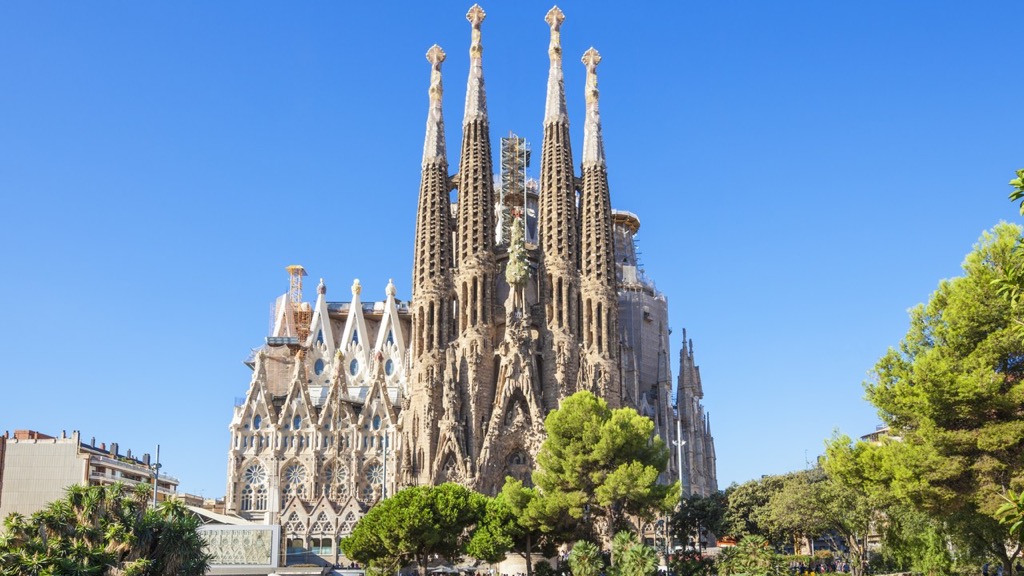
Bell towers have always been a feature of large churches and cathedrals, but usually they just have one, or sometimes two, one each side of the main façade. With La Sagrada Família Gaudí planned 12 bell towers, always in groups of four, they grow taller as you move from the Nativity façade, to the Passion façade, and then to the Glory façade. Each of the twelve bell towers represent an apostle, but the taller towers are for the more important ones. However John and Mathew were also evangelists, and they, along with Mark and Luke have even taller towers dedicated to them next to the central tower of Jesus Christ (these towers are still in construction). So our twelve bell towers belong to Peter, Paul, Andrew, James, Thomas, Bartholomew, Philip, James, Simon, Jude, Matthias, and Barnabas.
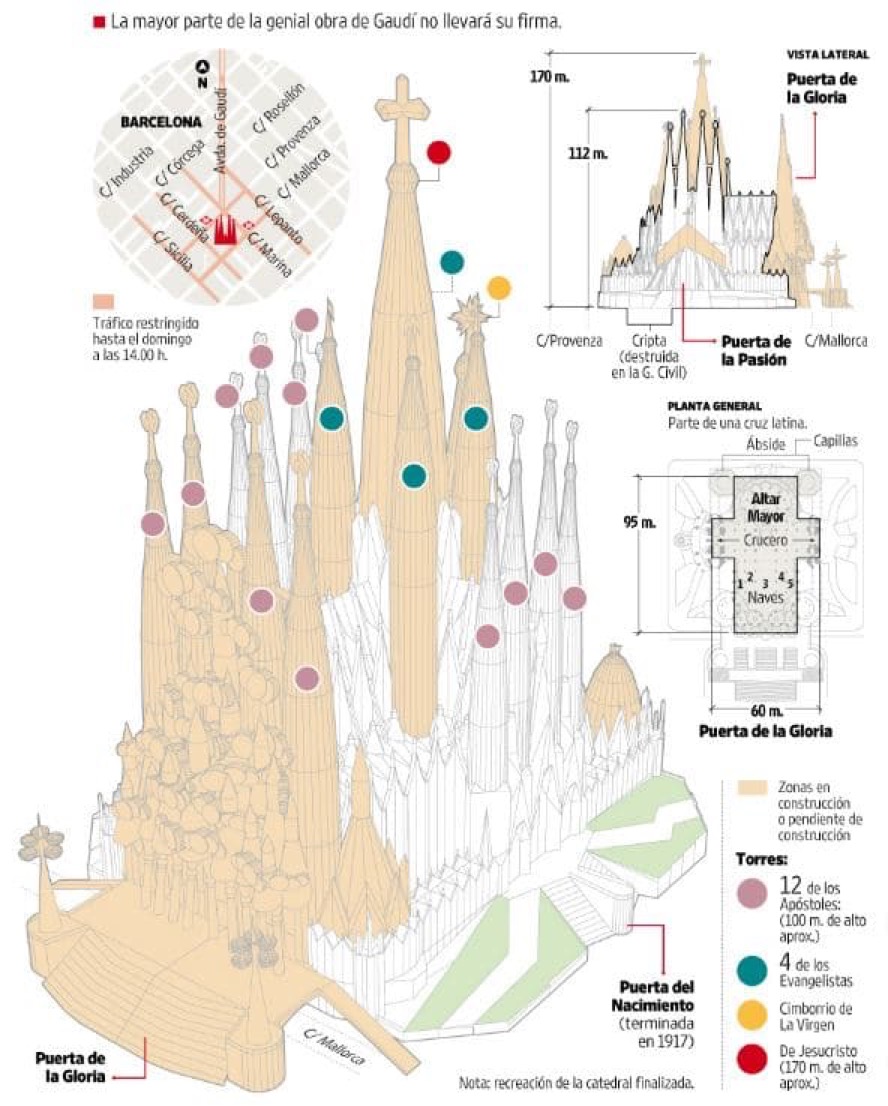

The bell towers are probably the most characteristics elements of the basilicas exterior. Each tower starts out having a square cross-section. About a quarter of the way up you may be able to see the large seated figure of the apostle to which that tower is dedicated (I could not see them). From that point the tower becomes a circular one, with a parabolic profile ending in a pinnacle.
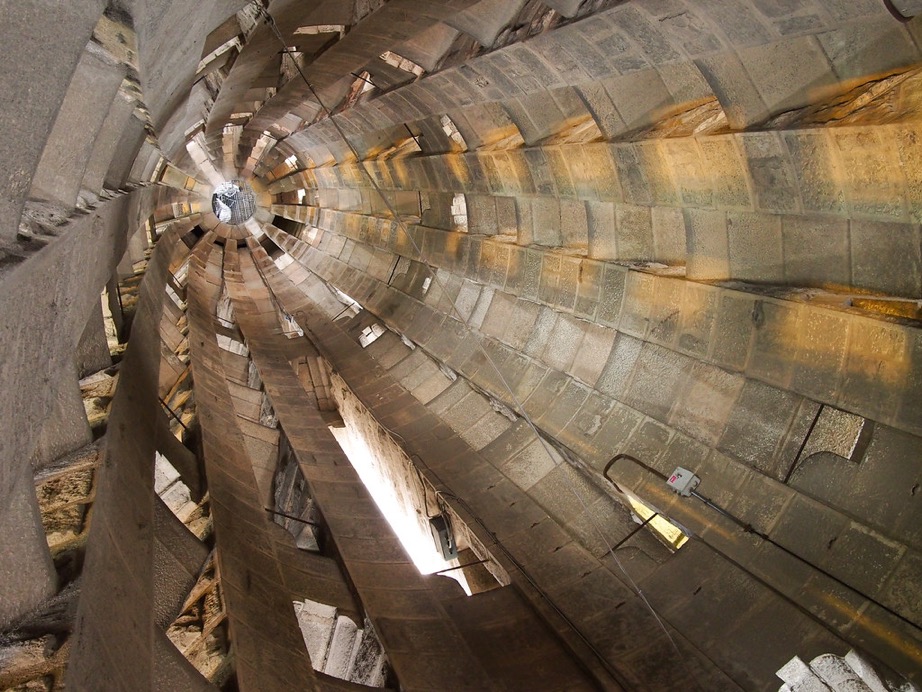
Each tower is fully accessible with a spiral stair that turns around an empty central space. You can see that each tower is punctured by a multitude of openings. These stone 'blinds' will allow the bells to be heard across the city. My understanding is that Gaudí planned for tubular bells, and that they will be the last thing installed in the basilica.
As you move up the bell tower it becomes a pinnacle that is meant to represent a Bishop's staff and abstractions of the Bishop's ring, mitre and cross, also there should be the capital letter of the apostle. I understand that the decoration is Murano glass. Somewhere there should also be the names of Jesus, Mary and Joseph linked together with palms and the word 'Sanctus', repeated nine time on each bell tower.

Colours also have their significance, with yellow for God the Father, red for God the Son, and Orange for the Holy Spirit. Right on top Gaudí finally decided on a star with a crown and signs mentioning 'Hosanna' and 'Excelsis'.
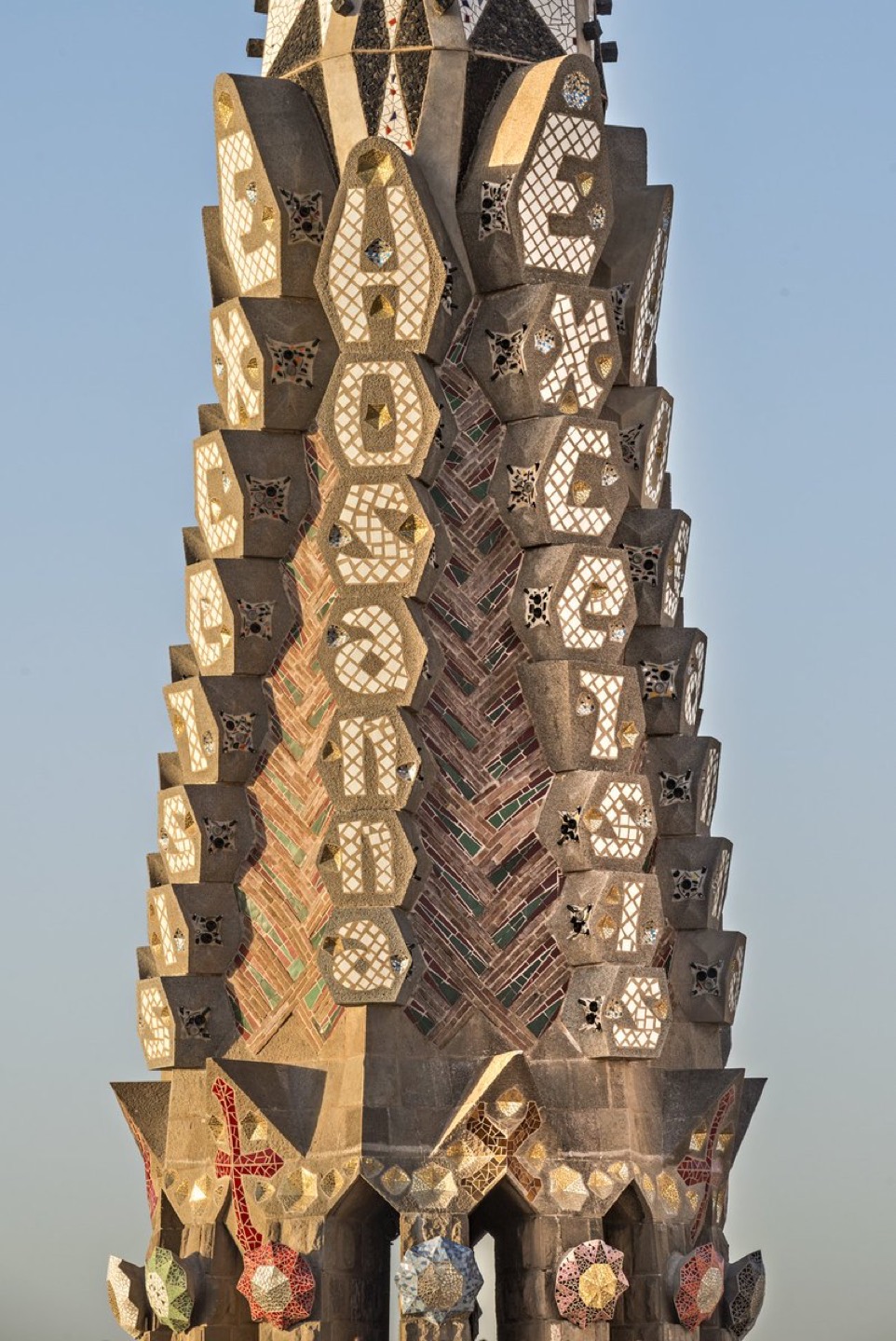
As you can see Gaudí has tried to exploit every surface, for a mix of decoration and symbolism.
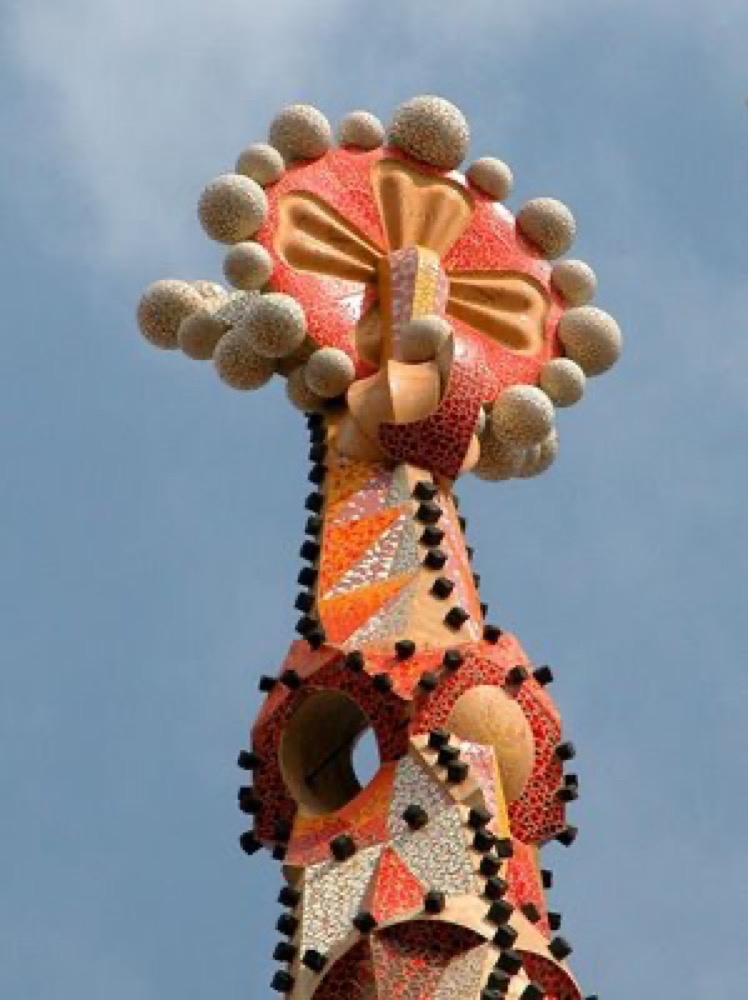
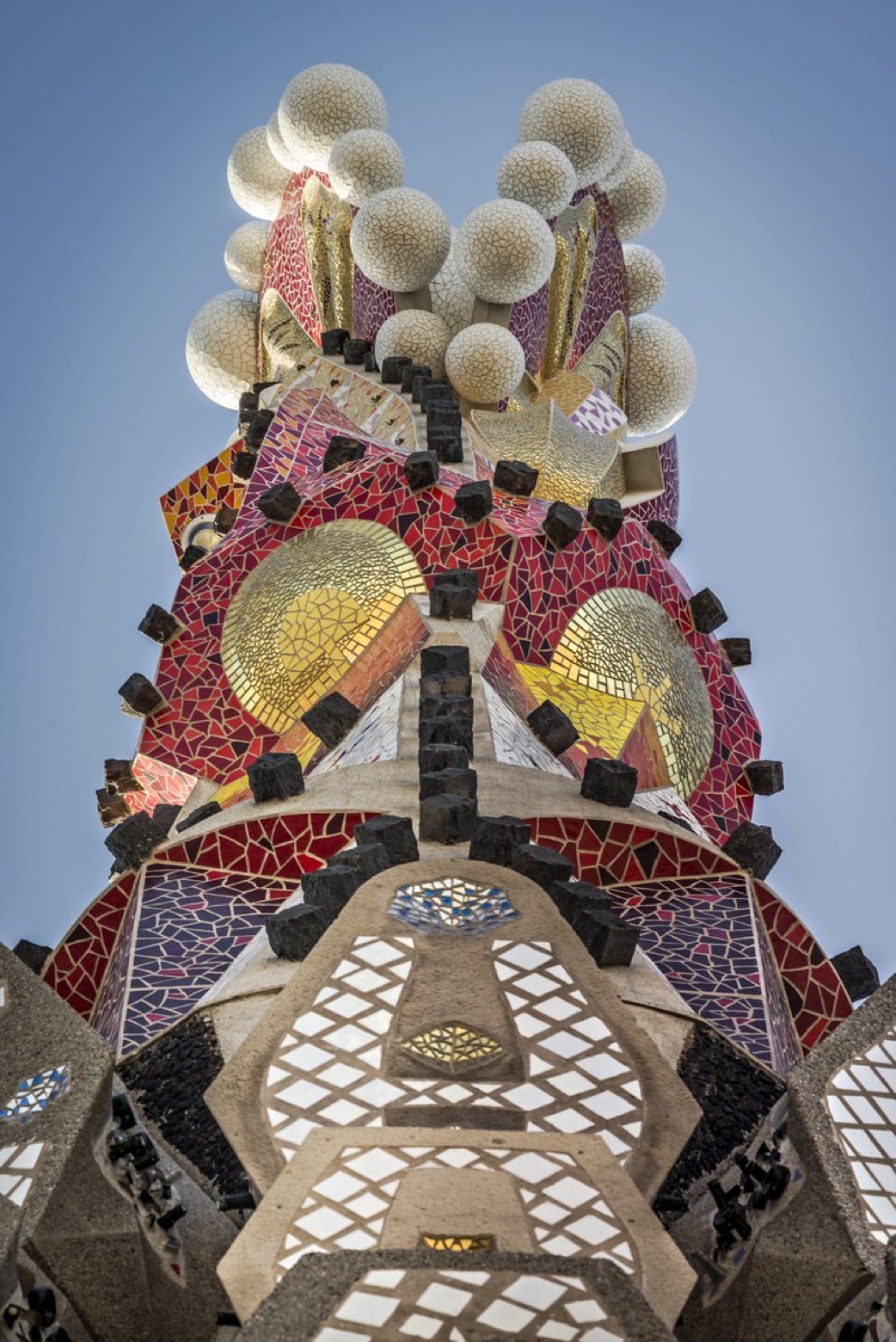
Entering the transept
As you enter through the main door in the Nativity façade it is difficult to capture that first impression. Standing in front of the Nativity façade my impression was that it was a modern take on a 'traditional' cathedral façade. I still had in my mind the first time I had entered through that same doorway in 1998 and I saw all the scaffolding, etc. And, of course, we all have a preconceived notion of the interior of a Gothic cathedral.
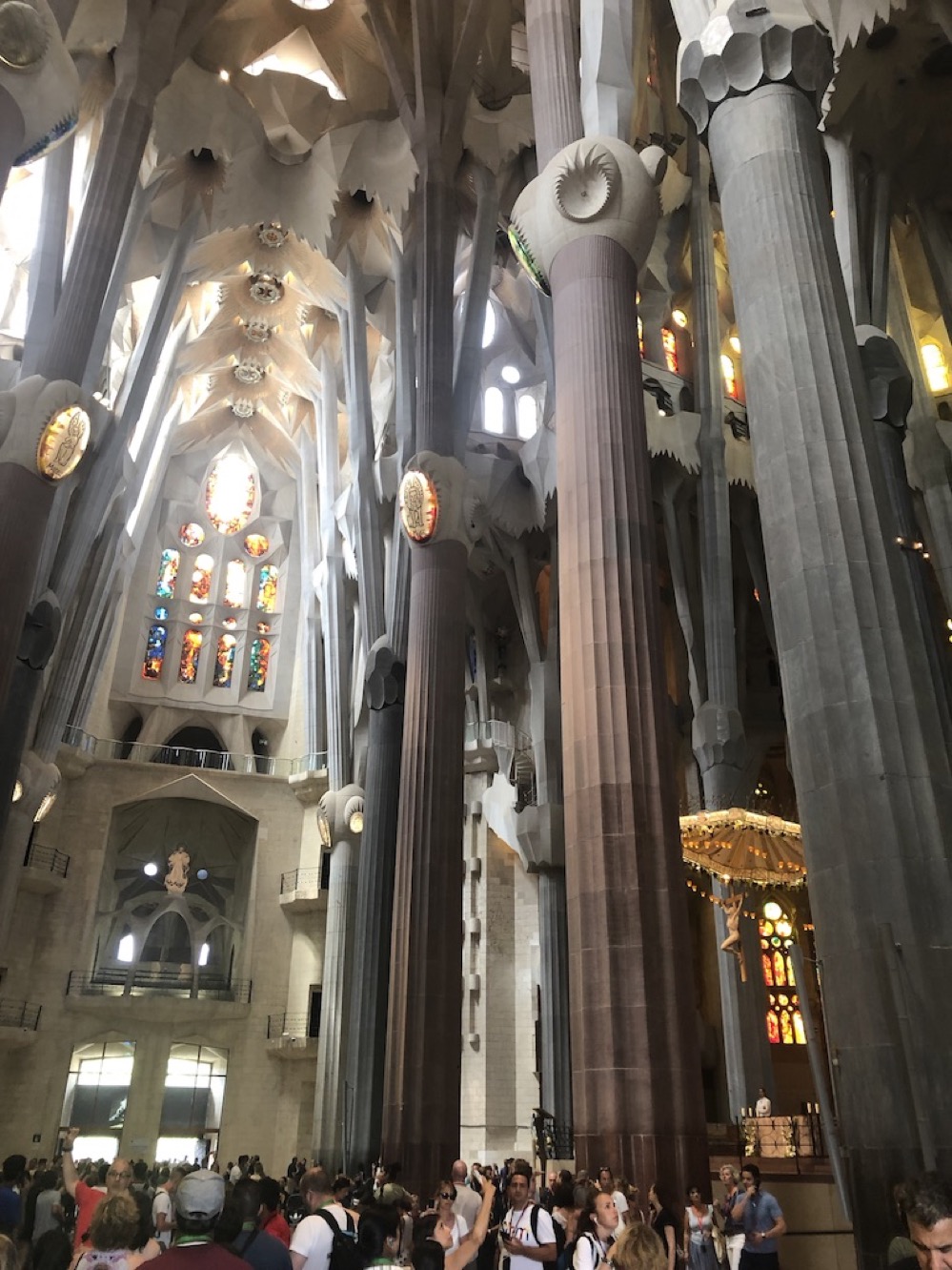
I don't think anything can prepare you for that first impression. The above photograph is the one I took when entering the transept. It does not capture my initial impression, but Rosemary Kneipp managed to get it just right when she wrote "Inside it is absolutely dazzling, breathtaking, overwhelming. There are no words to describe it and no photo to do it justice. It is the most amazing well of light imaginable. The brightly colourful stained glass windows which anywhere else would be gaudy, are quite superb."
We can see that as we enter the transept the altar is to the right, and the naves are to the left. We are looking a transept of 45 metres across and a nave and apse of 95 metres long.
You know it is supposed to be a modernist take on a Gothic cathedral, but this was far from being my first thought on entering the basilica. As you see, and will see below, the lines are not vertical because Gaudí designed the weights and forces to be absorbed by inclined columns and pillars. He avoided buttresses, so the two parallel walls that close the space are just that. They don't participate in keeping the basilica stable and upright, they are there to hold the stained-glass windows in place.
Looking back
As we walked into the church, we quickly looked at the nave before taking the lateral aisle on the left toward the main entrance, the Glory portal. We did not really look back at the portal we had passed through. Only on the far side of the transept did we look back at where we had entered. However we will 'look back' now, and what we see is perhaps the most marked different between a rather traditional Gothic style wall, set within the modernist Gaudí columns and roof.

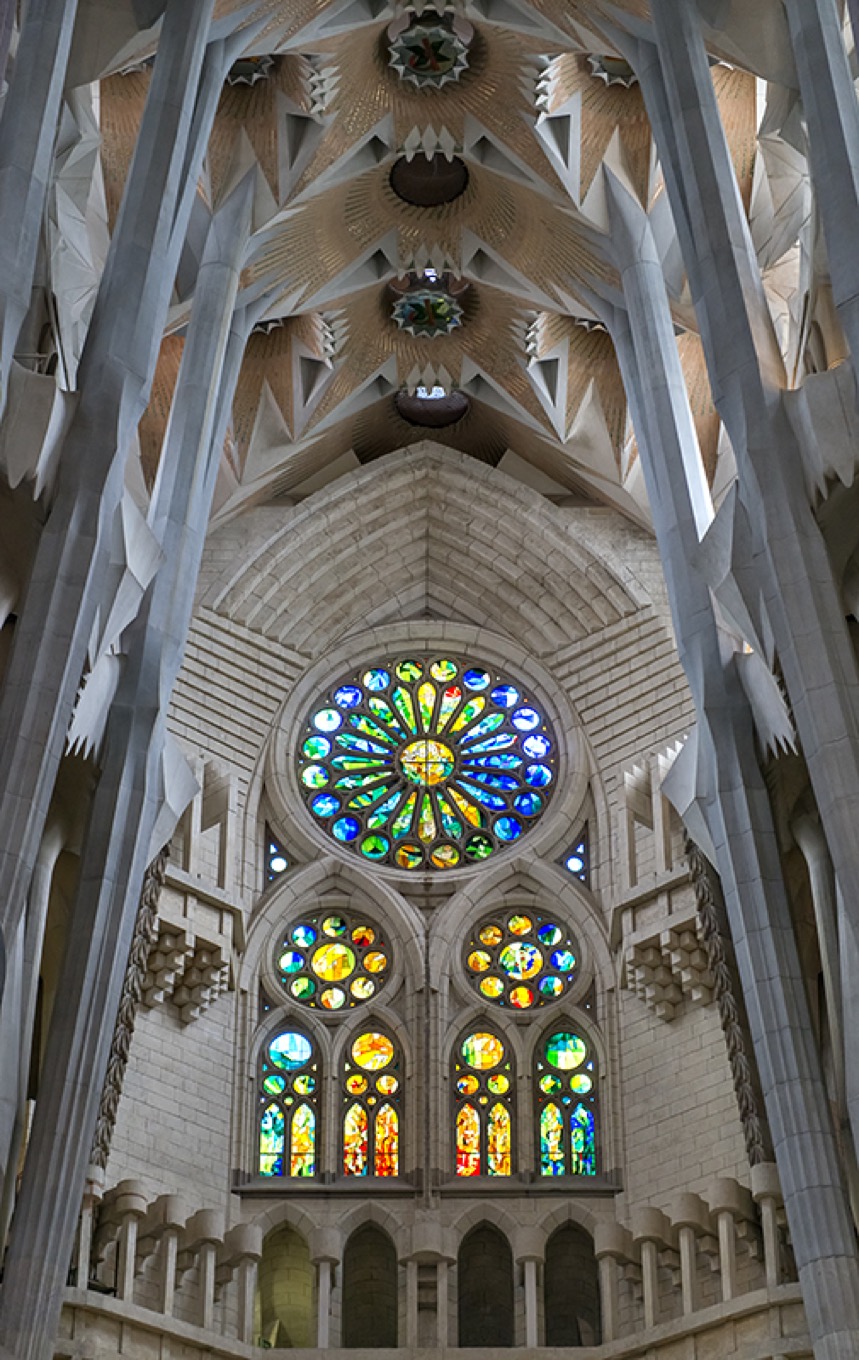
When we do look back we see Saint Joseph standing over the Nativity entrance portal. As is customary, he is shown as an elderly man. It is difficult to see but he is represented at the moment when he was chosen to be Mary's husband, and where, according to tradition, his staff blossomed as a divine signal. As a righteous, virtuous man, the flower that blossomed was a lily.
The lateral aisles
From the entrance portal and the transept we rapidly looked into the nave, before retreating and taking the lateral aisle on the left. This aisle goes to the Glory portal, which should one day become the main entrance to the church. Below you can just see the stone wall benches which allowed visitors to sit and admire the interior is comfort.

From this position you get a perfect view of the stained-glass windows on the far wall. The whole wall has a predominance of red's and yellow's. Whereas on our side, above our heads, the colours were predominately blue's and green's.
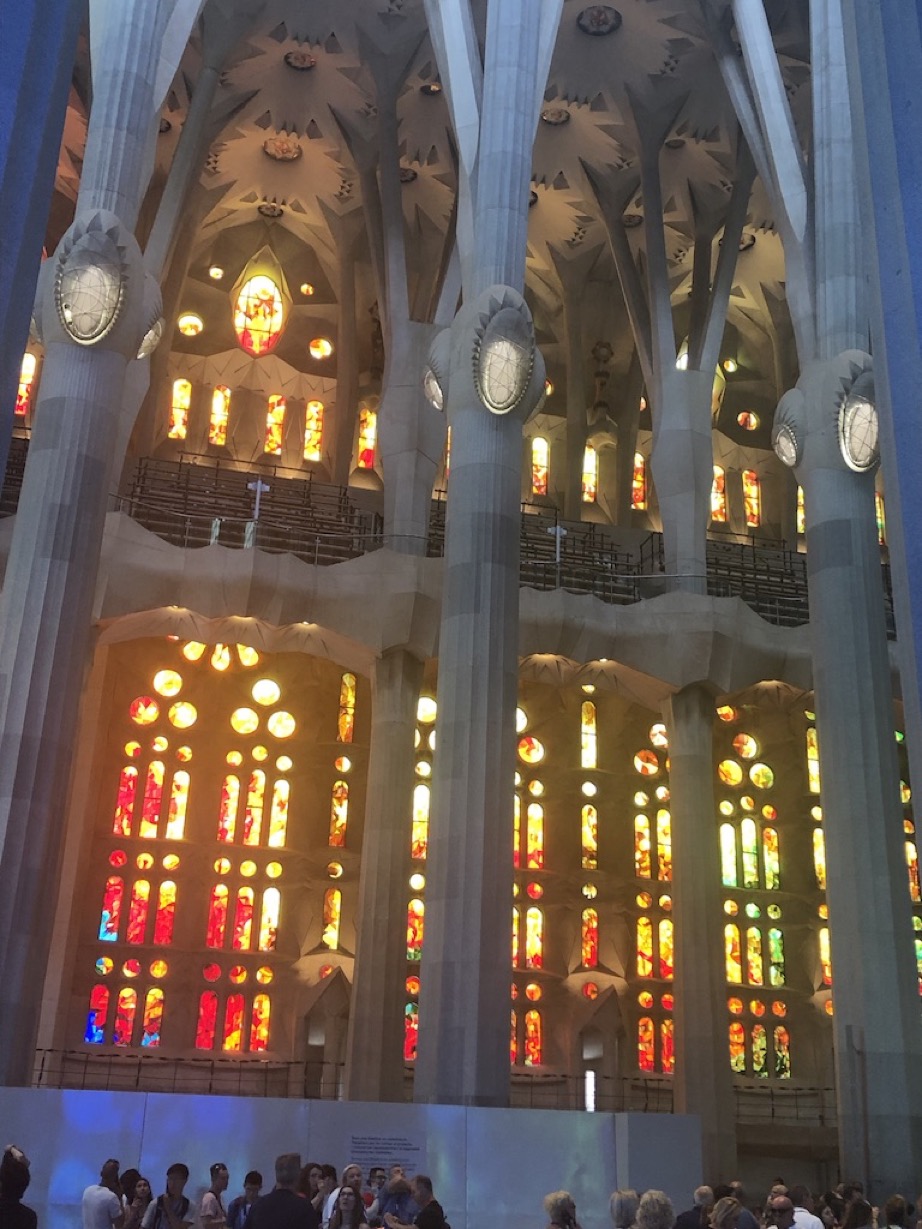
The stained-glass windows
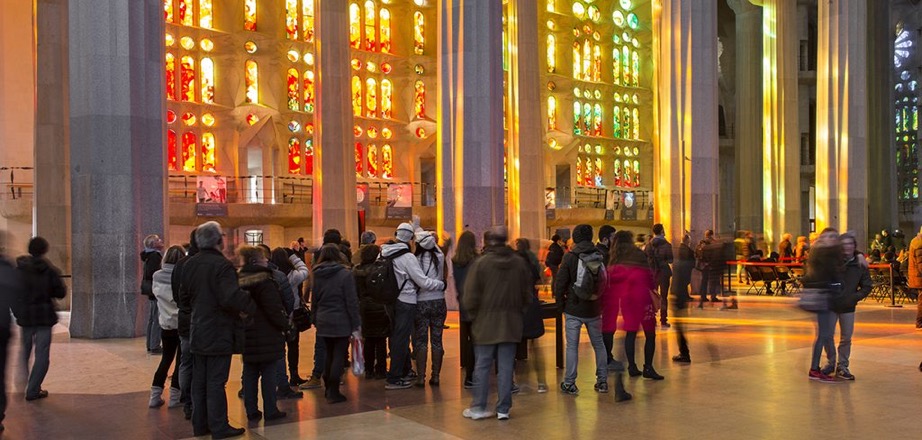
One of the main reasons for most of the major architectural developments in church design was to bring light into the interior, and nothing is more impressive than stained-glass windows. La Sagrada Família is constantly bathed in light from the multitude of coloured windows.

It would appear that each colour has its significance, i.e. white for holiness, grey for humility, blue for heavenly love, purple for God, violet for passion, and green for the triumph of life over death. Colours can also have 'negative' significance, i.e. yellow for jealousy, red for love-hate, brown for spiritual death, and, of course, black for death.
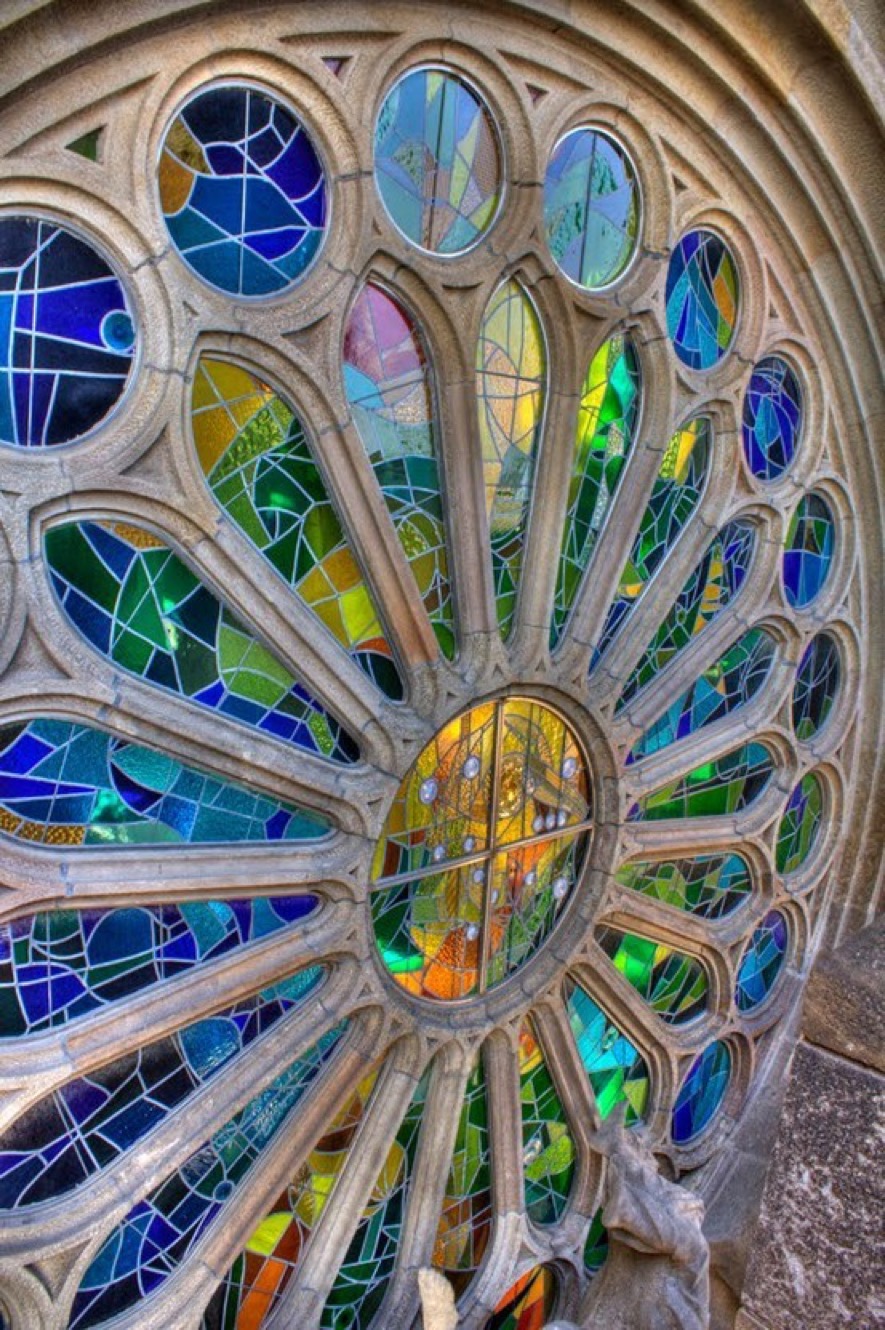
The glazier is the Catalan painter Joan Vila-Grau. In a classical Gothic cathedral the stained-glass windows are usually more colourful in the higher reaches where there is more light, and more transparent lower down where there is less light. Vila-Grau has reversed this, placing the more transparent glass higher up where the light can illuminate the mosaics in the golden vault of the ceiling. And the colourful illustrations and texts within the stained-glass windows are in the lower parts where they are easier to see and read.

If you look carefully you can see that in the upper portions of the windows only transparent glass is used. Both the textures and thicknesses are varied to better refract the light and 'open up' the colours in the natural light.
Gaudí quite rightly stated that "sunshine was the best painter", but he did not go very far in the developing the way the basilica was to be 'lit up'. We must remember he was far more involved in the building of the first walls and towers. However, Gaudí did develop a different way to make stained-glass windows, using the colour theory called trichromy. Instead of having pieces of glass of a wide range of different colours, Gaudí wanted to only used four types of glass, i.e. the three primary colours, yellow, cyan and magenta, plus a transparent glass as a seal. So what you have is similar to a computer printer, with different amounts of the primary colours mixed to create the final colour desired.
Gaudí tested this approach with windows in Mallorca and Montserrat, but finally for La Sagrada Família the traditional leaded glass approach was retained. The use of lead lines not only provides an excellent and well proven way to hold the glass in place, but the lines add a certain dynamism to the window. The lead lines also allow the designer to add names and messages within the stained-glass windows. Vila-Grau broke with tradition in many ways, for example he shied away from figurative representations preferring abstract interpretations. Also Vila-Grau did the opposite of what we see in the Gothic cathedral, he included the richest iconography in the parts closest to the faithful so it can be better read and interpreted. We have to remember that Gothic stained-glass was meant to be educational for the vast majority of people who were illiterate. They were trying to tell a story. Today in La Sagrada Família the objective is quite different. Each window features a name of a saint or sanctuary, and for Vila-Grau the true importance of the stained-glass windows is to create a feeling of spirituality.


The combination of colours in the stain-glass windows is graded as you look across each side of the nave. On the Nativity side the yellows move in to greens, and then in to deep blues. And on the Passion side they go from yellow in to orange, and then in to red.
In my humble opinion Gaudí may have imagined and designed a unique structure, but it's the stained-glass windows of Vila-Grau that have breathed life into the building.
The Glory portal
We reach the end of the nave, only to find the beginning. In fact the Glory portal will become the main entrance to the basilica when it's finally finished.
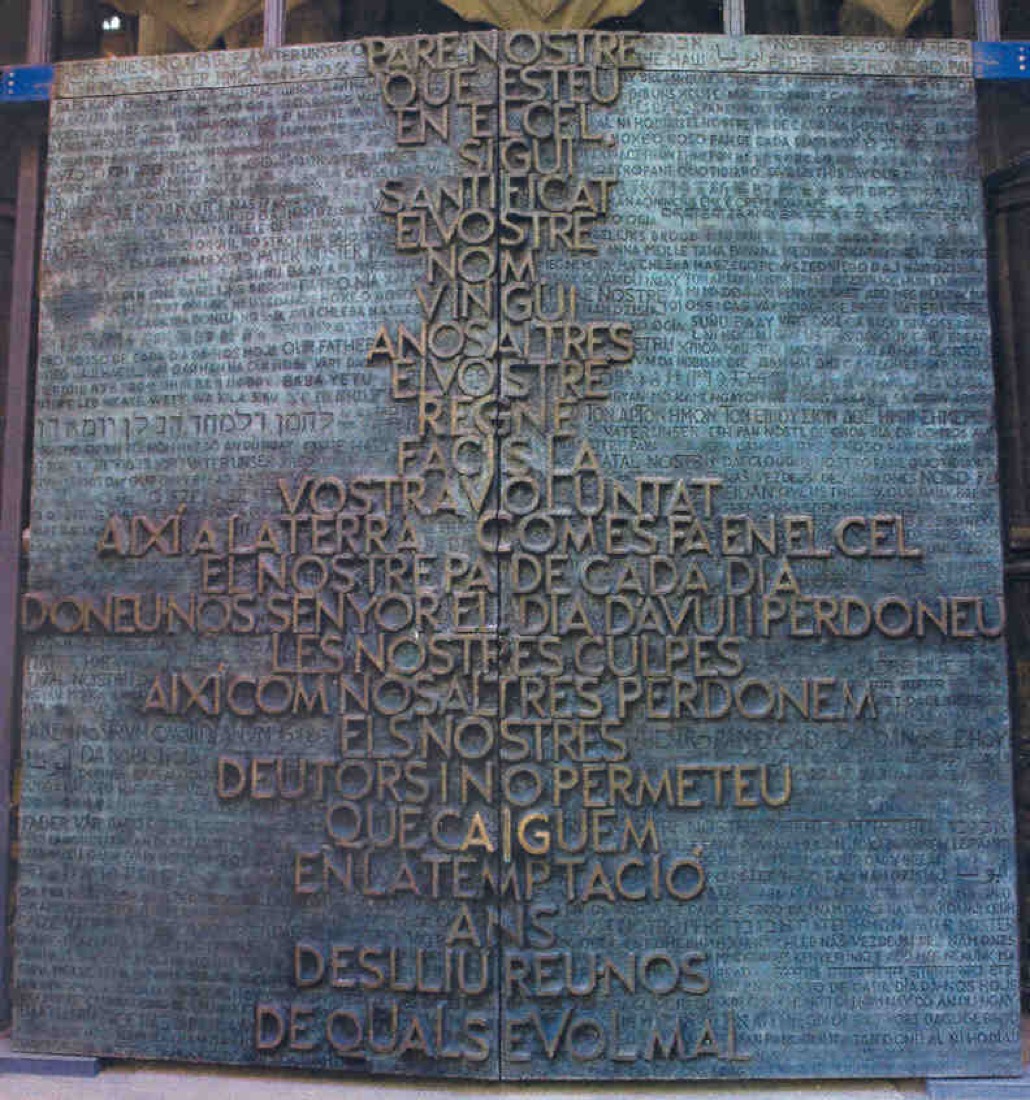
The first thing you see are the massive bronze doors created by Josep Maria Subirachs i Sitjar (1927-2014), a Spanish sculptor and painter. Mounted in 2009 the doors are 5 metres high and 5 metres wide. Reports differ as to the texts on the doors. Some texts tell us that the doors are inscribed with the Lord's Prayer in Catalan and 49 other languages, with each letter in relief (the Catalan version is bolder and in high relief). There is a good chance you will spot the English version, but will you be able to find the versions in Quechua and in Wolof?
Other texts tell us that the petition "Give us this day our daily bread" is in 50 languages. And Subirachs actually made a total of seven doors, representing the seven sacraments, and each containing the petition "Our Farther". Over these seven doors there is a total of 84 languages used.
The photograph above is of the exterior doors, and below we have a photograph of the interior doors.
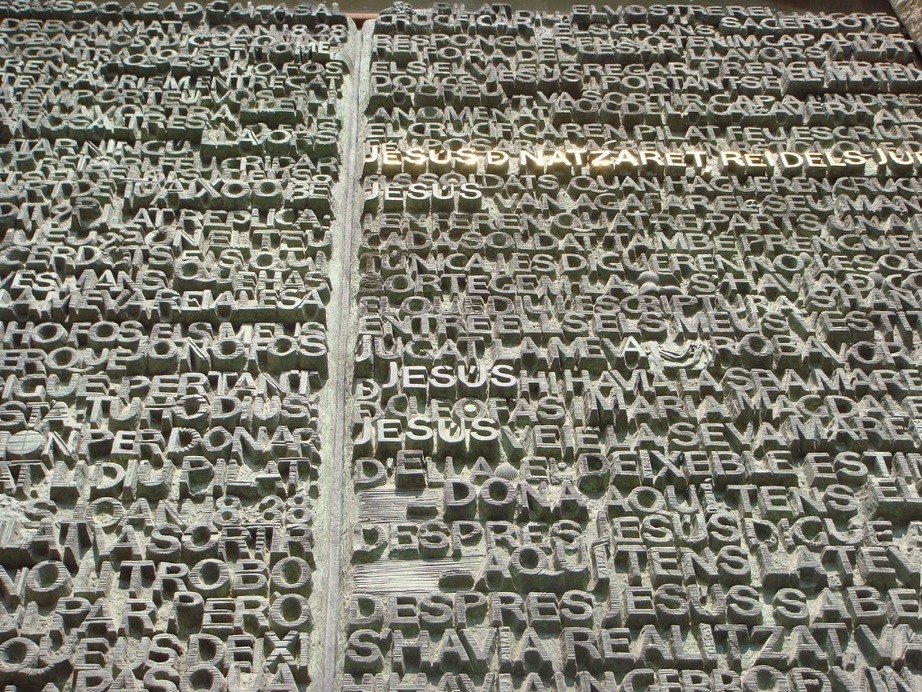

As we returned up the nave we could look back at the Glory façade and view the impressive and, oddly, totally transparent glass windows. The Glory façade has not actually been sculpted yet, so it's possible that the windows will also become 'stained' one day.
Occasionally on my two webpages dedicated to La Sagrada Família I will duplicate this little list of infographics dedicated the church. Check out La Sagrada Família from Taylor's University and the Infographic La Sagrada Família by Jaime Serra of La Vanguardia.
The nave
We are now walking back through the nave towards the altar, and it's time to admire the majesty of the whole space.
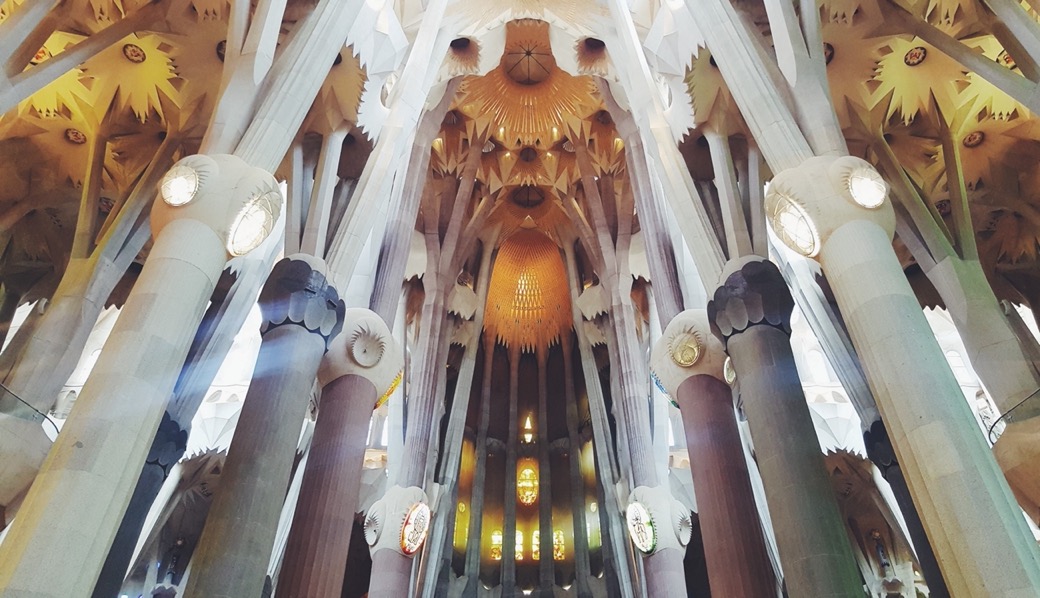


The floor plan shows a central nave 30 metres wide, and on each side two additional lateral naves, each 7.5 metres wide, for a total width of 60 metres. The total length of the nave is 80 metres.
There is no better place than here to mention that almost everything about La Sagrada Família is a mix of mechanics and symbolism. And this is just as true for all those columns that we see supporting the vaulted ceiling over the nave. Firstly the columns are slightly tilted to take the load from the ceiling. This frees up the walls to be just responsible for housing the stained-glass windows. According to a webpage on La Sagrada Família blog Gaudí developed a double twist column. The Solomonic column is a corkscrew-like spiralling shaft which you often see supporting a ciborium or canopy in many basilicas. The blog described this process, as like a profiled template being drawn and twisted along the length of the column, creating the effect of a helical twist. What Gaudí added was a second pass with the template, but turning in the opposite direction, so creating two overlapping Solomonic column twists. What emerged was a column that was thinner at the top, and starting with a star profile at the base, as more and more striations are added it also finally becomes a circle at the top.
Each column is dedicated to a saint, so Gaudí was looking for a form that would symbolise an ascension into heaven. If we look carefully we can identify four different types of columns.

First, there are the columns on each of the four corners of the crossing between the nave and the transept. These have to support the load of the central lantern of Jesus Christ, as well as part of the weight of the four towers of the Evangelists that surround this lantern. For this reason, they are the most important columns.
Second, there are eight columns that bear the load of the towers of the Evangelists. They are also located on the crossing, behind the first group.
Third, there are the columns in the apse and nave. Those in the apse bear the load of the tower of the Virgin Mary, and are very close together. The same columns also support the vaults in the central nave and part of the side naves.
Fourth, there are the columns that separate the side naves from the main nave bear the weight of the choir and the side naves.
If you look carefully the more important the column, the more points there are in the star profile used for the base of the column (so going drown from 12 points, to 10, the 8 and finally 6). Columns are composed of a base, a shaft, and a 'capital', and the height of the column is always double the number of points in the star profile used (i.e. 12 points in a star equals a column height of 24 metres).
We begin to see that in many ways Gaudí was driven by the same impulses that would have driven the builders of the first cathedrals. The need to create a specific 'feeling' (in his case one of quiet worship and inner peace), the need to use materials with the right structural properties, and the need to find adequate locally available sources for them. Gaudí actually commissioned tests of different materials from a local engineering school. This suggested that he could use a red granite porphyry for the biggest columns, then a black basalt, then a grey granite, and finally a yellowish sedimentary sandstone for the smallest columns. However, the result would have required columns with massively larger profiles, so for a time Gaudí considered using iron columns, before finally decided on reinforced concrete. But the idea of a hierarchy of colours remained, so the solution was a stone cladding around a core of reinforced concrete.
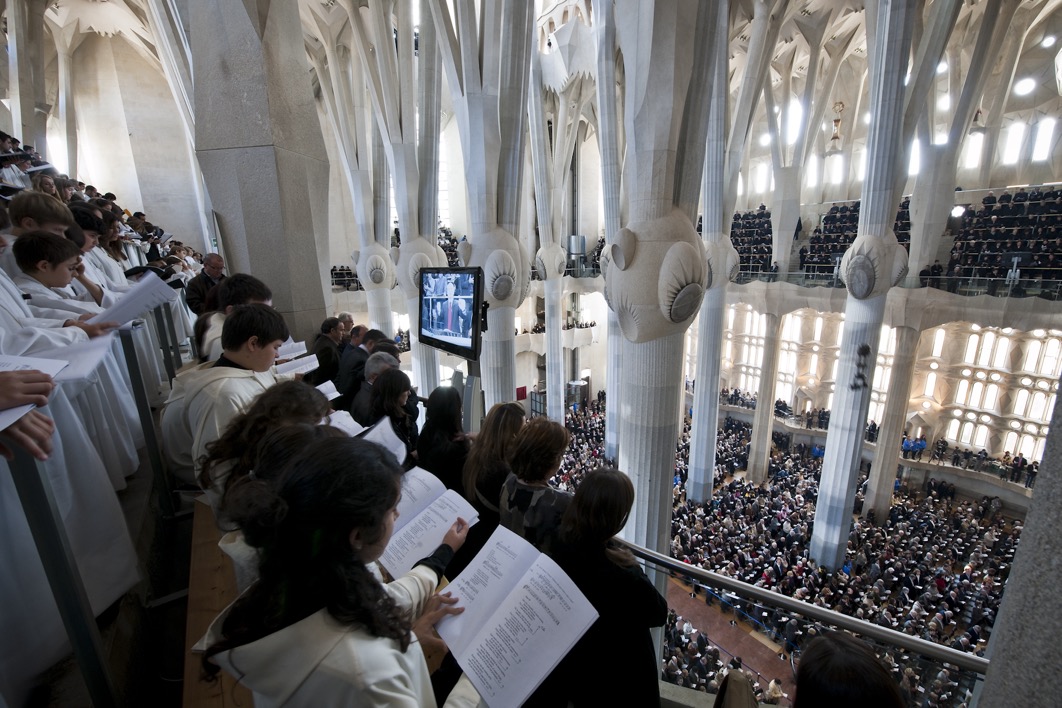
The outer aisles, or most lateral naves, are covered and support a choir that can hold more than a thousand singers.

You should never underestimate the efforts made to include message and symbolism is every part of the basilica. Above we can see the railings of part of the choir, where they play out the notes of 'Veni Creator Spiritus'.
The ceiling
For me the ceiling enshrines the true genius of Gaudí. All the discussions about columns, walls, stained-glass windows, etc. is all designed to hold up and light up the ceiling.
Only one person has really managed to capture the ceiling in all its splendour, and that is Helen Betts. She has posted some fantastic photographs, some of which I have reproduced here (hope she does not mind).
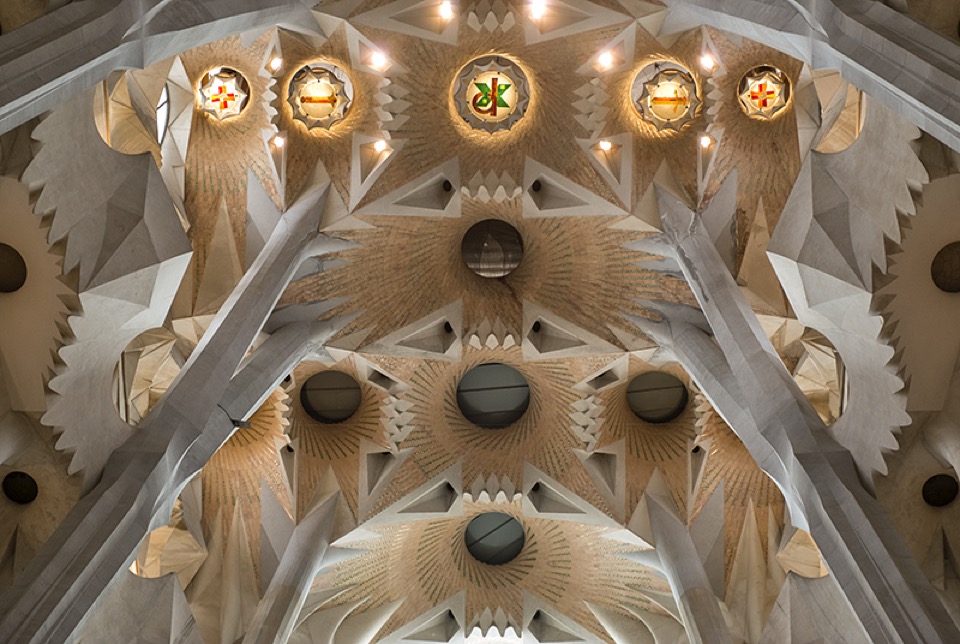


Traditionally it was very difficult to build a water tight roof. The best approach was to make the roof at an acute angle so the rain water would run off quickly. And in addition they would use a roof attic, a space between the roof and ceilings, ventilated by small openings so that it would dry out quickly. Gaudí did the same. Below we have a model of the roof showing the extreme sloping roof. Repair work on the roof is actually performed by trained rock climbers.

In addition Gaudí also created three attics over the central nave. Light enters the attics, and there are a series of holes a bit like open pots that let light and air into the spaces created, and also down into the basilica through holes in the vaulted ceiling.
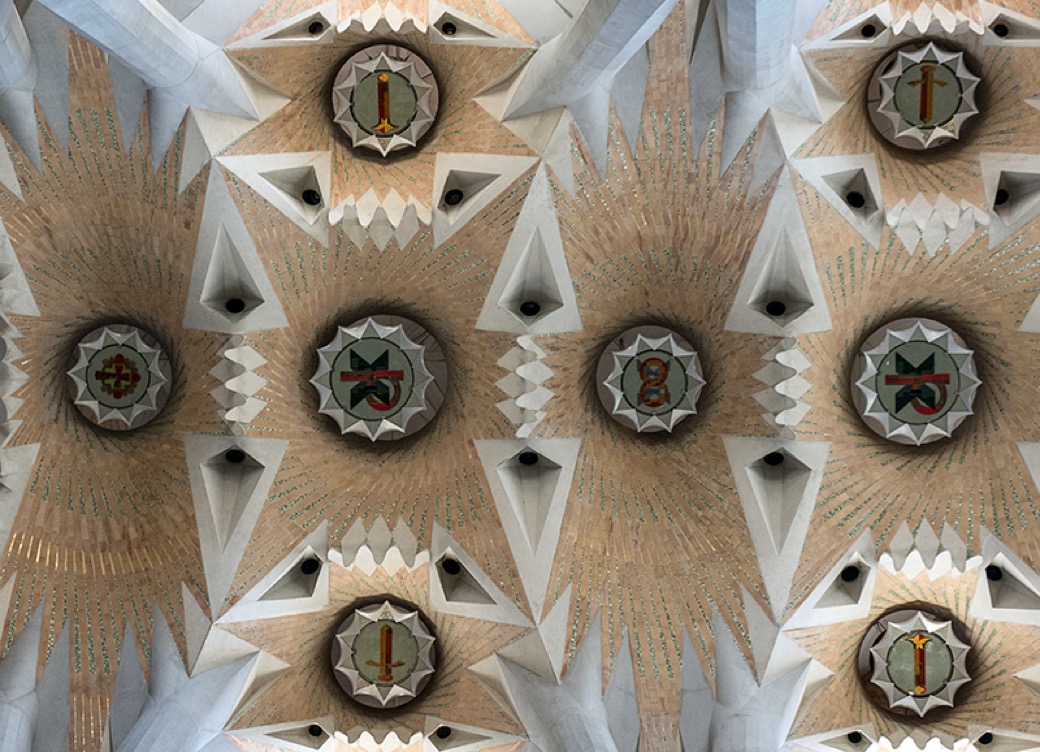

The apse
Many of the websites talk about the apse, the presbytery, the altar, and even domes, 'cimborios' (the part that actually supports a dome and has windows to let light into 'the crossing') and obelisks (a name some have given to the towers), without really describing what they are. Wikipedia provides a simple description to which we can add a few additional features.

What we have done so far is to have entered through the transept where a porch is indicated (the Nativity portal), walked along the lower aisle, had a look at the 'narthex' (a kind of lobby where we found the Glory portal), and then walked back up the nave towards the apse. Below we have the actual plan of the apse, etc. of La Sagrada Família.

Imagine we are standing in what is often called 'the crossing', the junction of the transepts and nave. Some consider the transept as a single arm crossing the entire width of the church, others see it as two transepts or arms, one on each side. The crossing is often surmounted by a tower or dome (you should have been able to spot the dome in some of the photographs). To get a better impression of what is above the crossing we need to look at the expected profile of the basilica when completed in 2026. We can see that there will be a huge central tower to be dedicated to Jesus Christ.
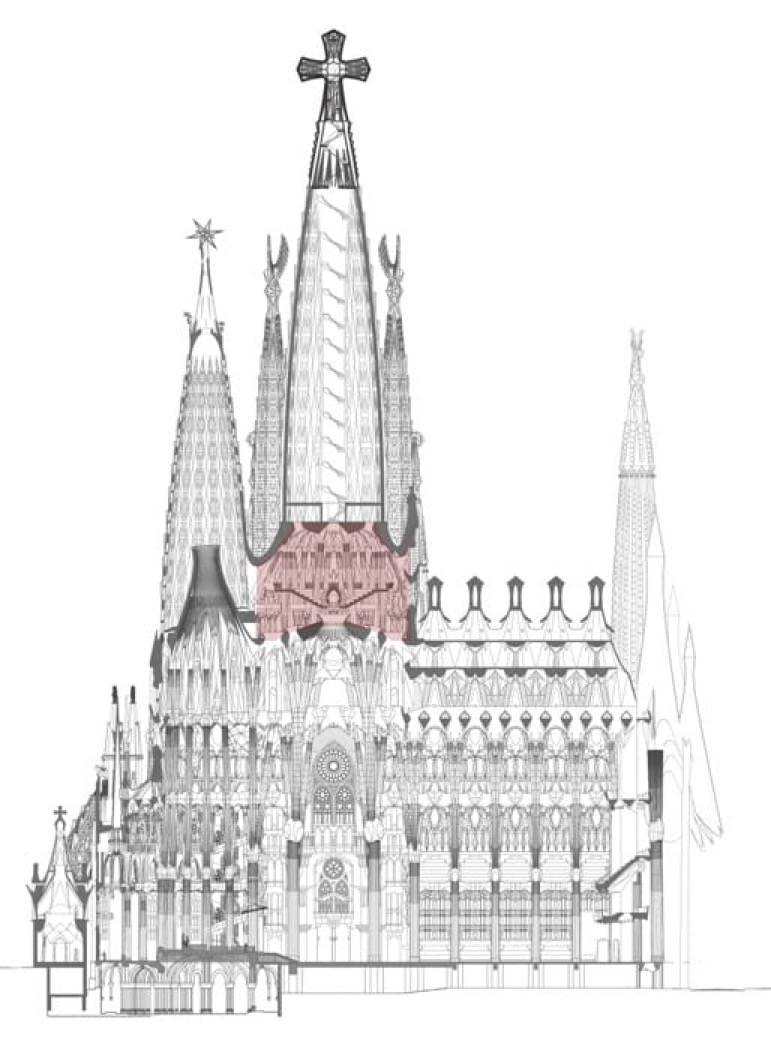
This central tower is linked to four smaller towers, dedicated to the four Evangelists. And above the apse there is another tower dedicated to Our Lady. You can see the dome over the crossing, but you can also see that above the dome there is an additional construction called the 'Sala Creuer' (the 'Crossing Room'). Below you can see how the columns of the crossing reach into the central vault and provide the support needed for the tower of Jesus Christ (you can also see the roof of the 'Sala Creuer').

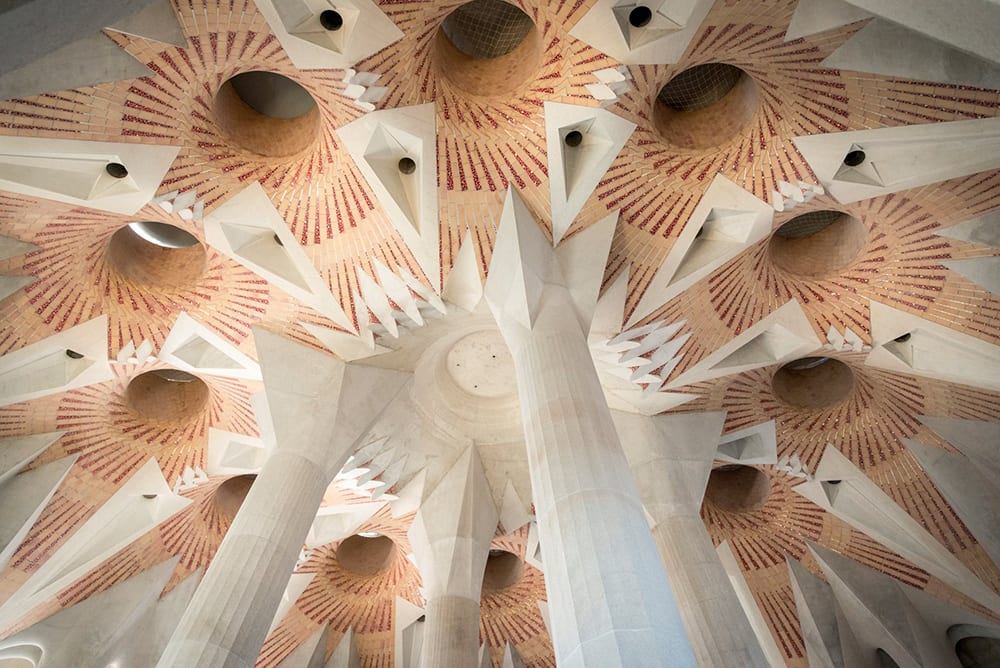
What is amazing is that inside the basilica you have the impression that everything is finished, yet on the roof, above the crossing, work has just started on a massive series of additional towers, including the 170 metre tower dedicated to Jesus Christ. The other towers are the four dedicated to the Evangelists (each only 125 metres tall), and the one above the altar dedicated to Our Lady (140 metres). To give you a perspective of the size of these towers, below we can see the tower of the one of the Evangelists being built.
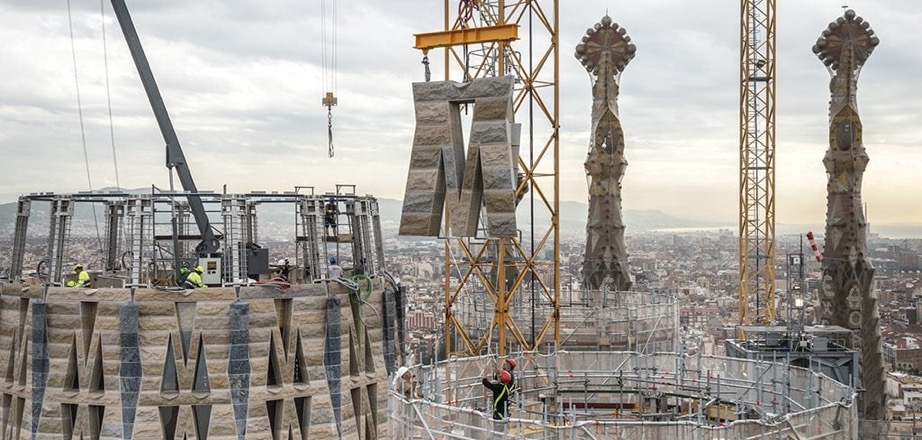
Now returning to the apse, we can see a fourth arm of the crossing. This is the chancel where you find the altar, the choir, and sometimes the presbytery (another name for the sanctuary or area around the altar where you might find a shrine with a relic). There is also a broader definition that includes side chapels and the ambulatory that goes behind the altar.

In the above drawing you should now be able to identify the apse, the altar and the seven side chapels. This area is not really accessible to tourists, so below I've just included a couple of photographs, one of the chancel roofing and the other of the altar itself.


Leaving through the Passion portal
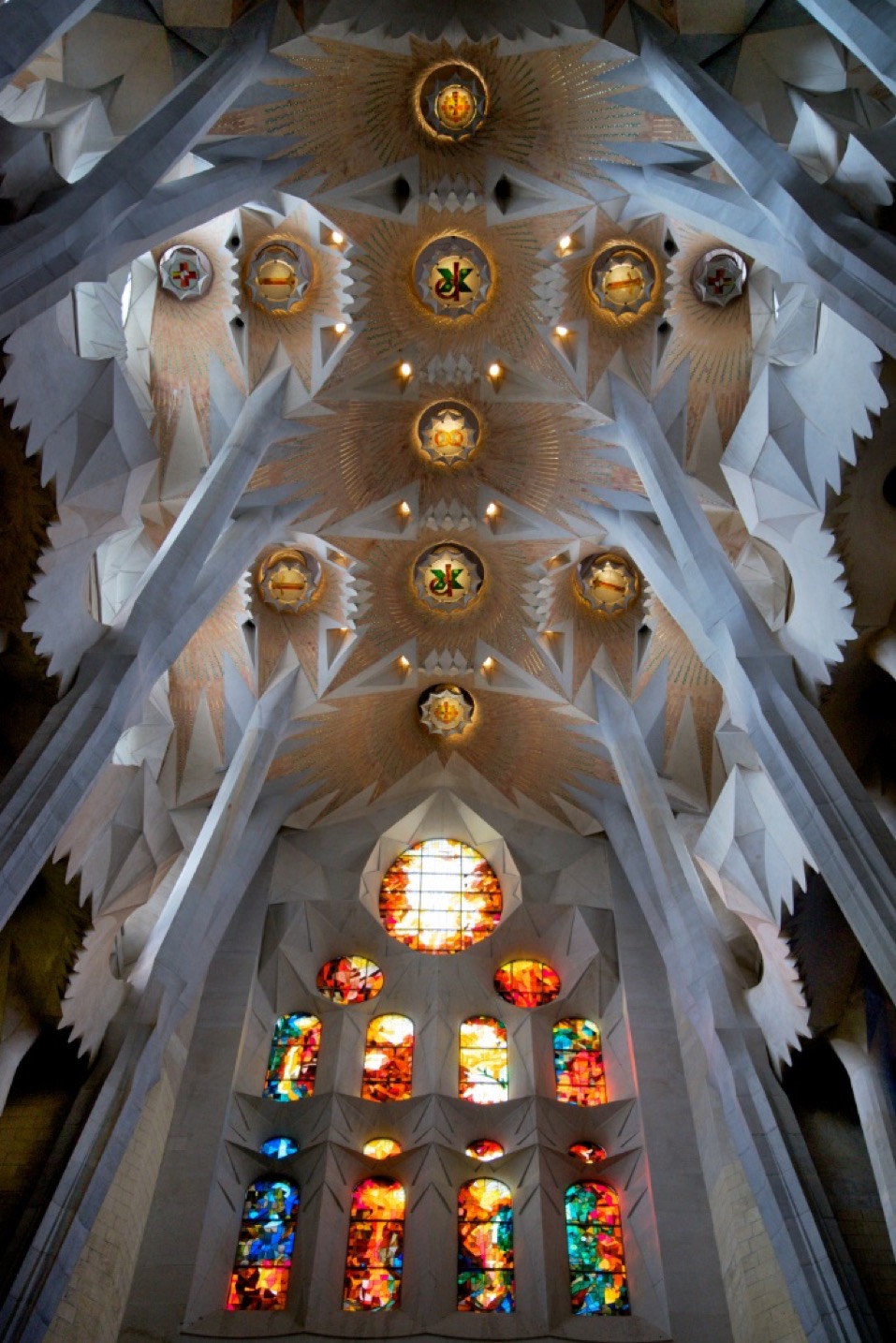
The stain-glass windows above the Passion portal was the first made by Jean Vila-Grau. It was the only window where Gaudí had already established the theme, i.e. The Resurrection, or the triumph of life over death. In addition the external structure had also already been established. It would appear that no one had explicitly decided on the style for the windows, but Vila-Grau presumed that because he was an abstract artist, that the windows would be of abstract design. He chose the idea of the triumph of light over darkness, however many people 'see' in this window a resurrected Christ. The initial commission, made in 1999, was so successful, that Vila-Grau was entrusted to design and create all the stain-glass windows in the basilica.

Before leaving the interior we could look back down the lateral aisle and see the very visible and elegant spiral stairs disappearing into the clouds.
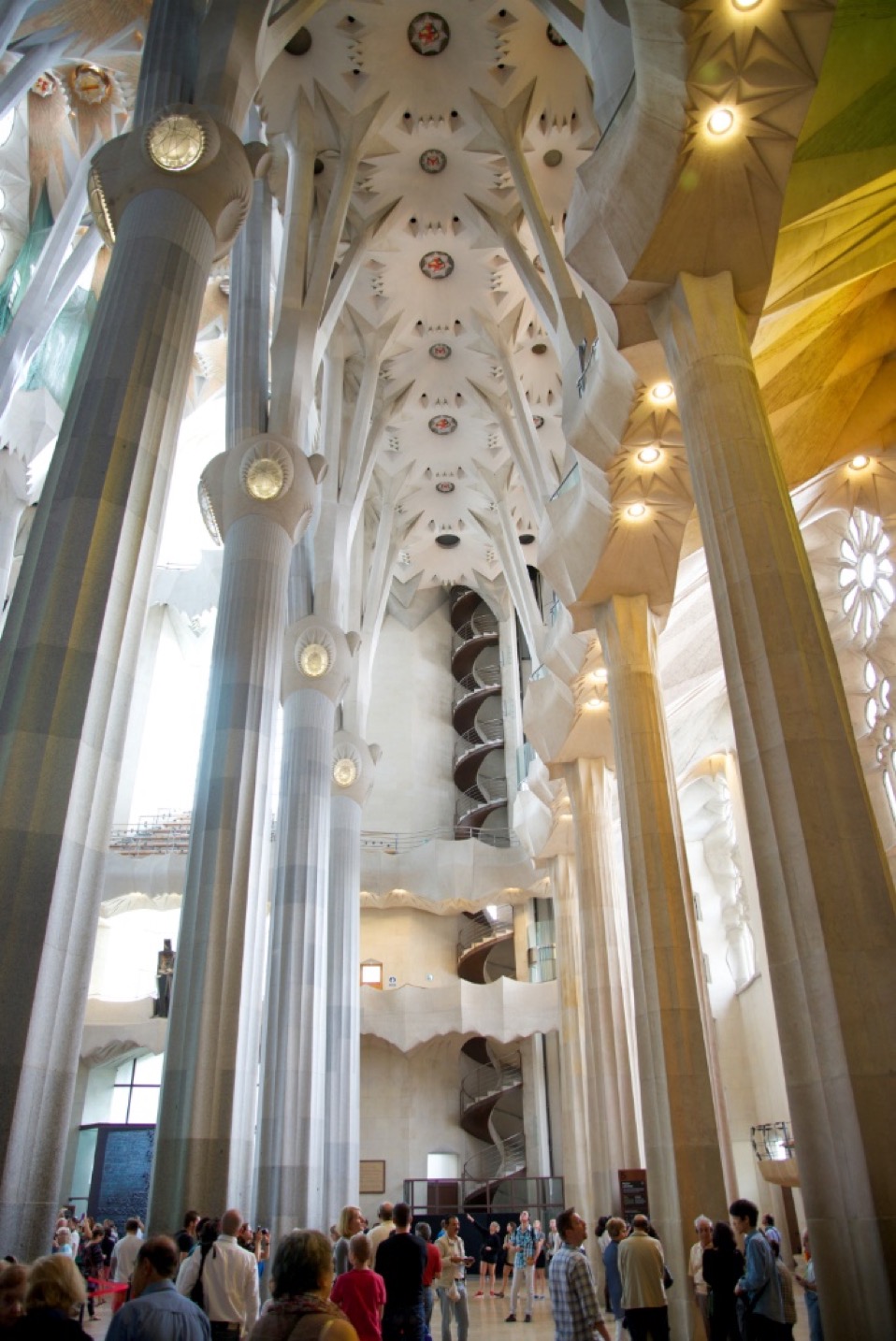
The Passion façade
Outside it only remains for us to view the Passion façade before making our way to the exist, and a welcome cup of coffee. Coming out on the terrace there is no way to really appreciate the full scope of the façade. Below we have a photograph taken from some distance away.
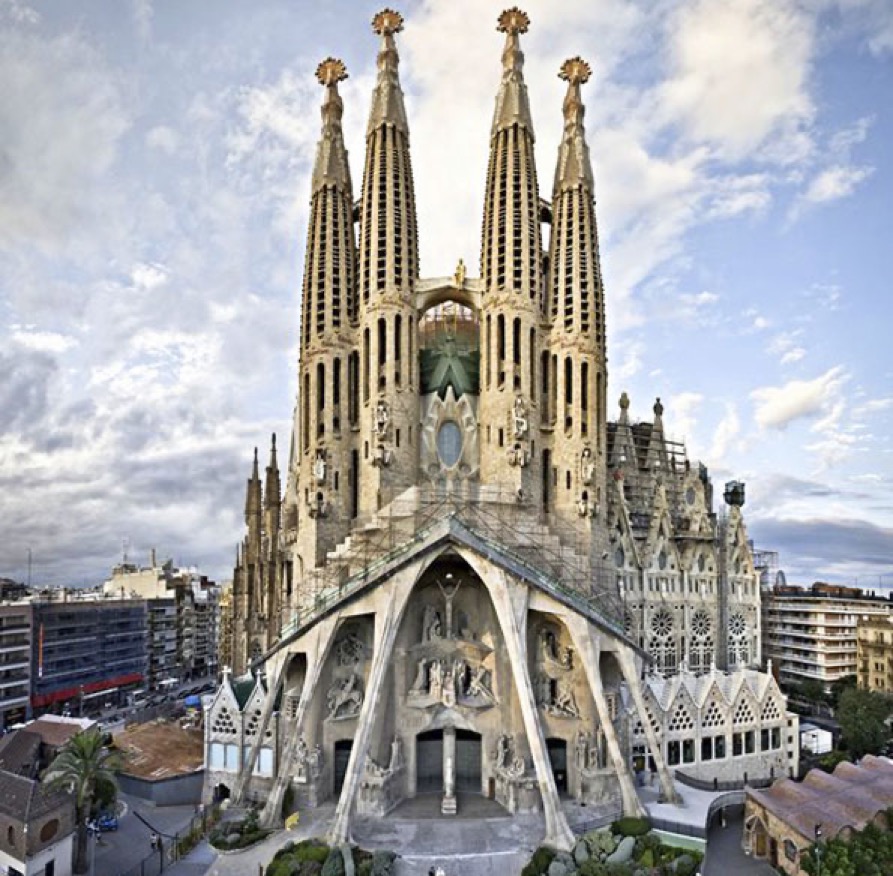
The Passion and Nativity façades are completely different. Gaudí himself felt that people would not like the Passion façade (and he was right) because it deals with the drama of the sacrifice of Jesus Christ. There are no joyous shapes and symbols, everything was designed to be dark and sinister. The sculptor Josep Maria Subirachs gave the figures a very angular, dramatic character, exactly what Gaudí wanted.
The Glory façade
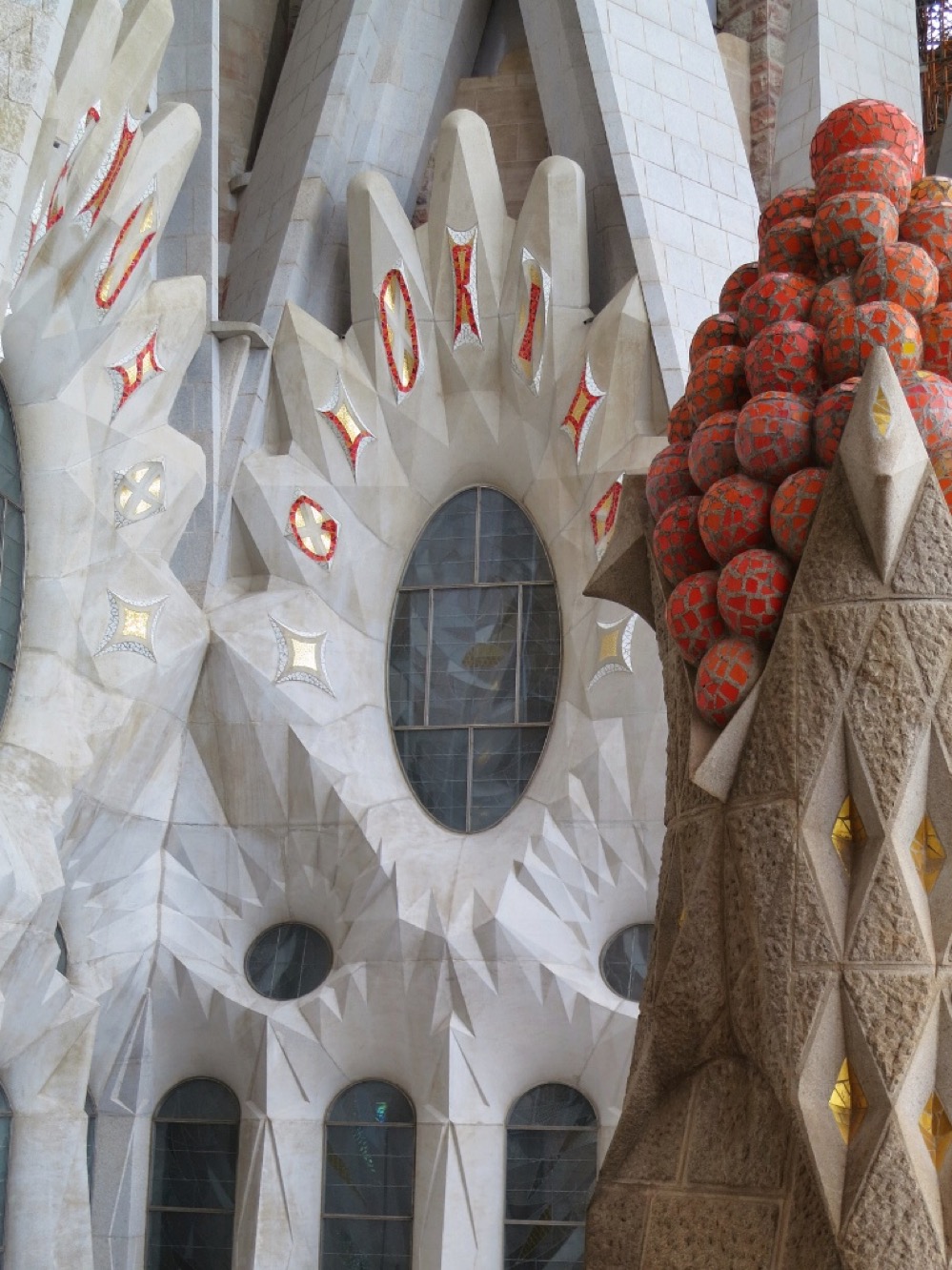
On the way to the exist and our well earned cup of coffee, we pass by the Glory façade, which I understand to be not yet completed.
What will La Sagrada Família look like when finished?
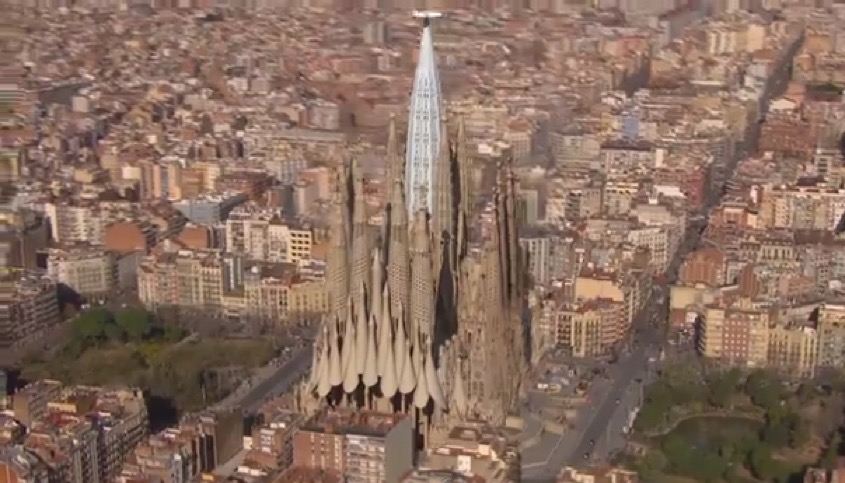
The best way, a perhaps the only really understandable way, to see what La Sagrada Família will look like in 2026, is to check out these videos:-
This is a video from 2012 on how it will be completed
This video dated from later 2017 and covers the technology being used to complete the basilica
And this video presents the building work going on in 2017.
The best way to keep track of progress is through the blog Sagrada Família.
Occasionally on my two webpages dedicated to La Sagrada Família I will duplicate this little list of infographics dedicated the church. Check out La Sagrada Família from Taylor's University and the Infographic La Sagrada Família by Jaime Serra of La Vanguardia.
References
The Lasting Relationship between Antonio Gaudí and Barcelona, Erica Cline, Master's Theses, 2011
Remodelació i Restauració de la Nau de Blanqueig de la Cooperativa Obrera Mataronense Projectada per Antoni Gaudí, Manuel Brullet i Tenas
The Catenary - Art, Architecture, History, and Mathematics, Gail Kaplan
Gaudí's Hanging Chain Models, Rafael Gomez-Moriana, 2012
Studies of Gaudí's "Cripta de la Colonia Güell", P. Roca, 1996
Structural Design in the Work of Gaudí, Santiago Huerta, 2006
On the edge…
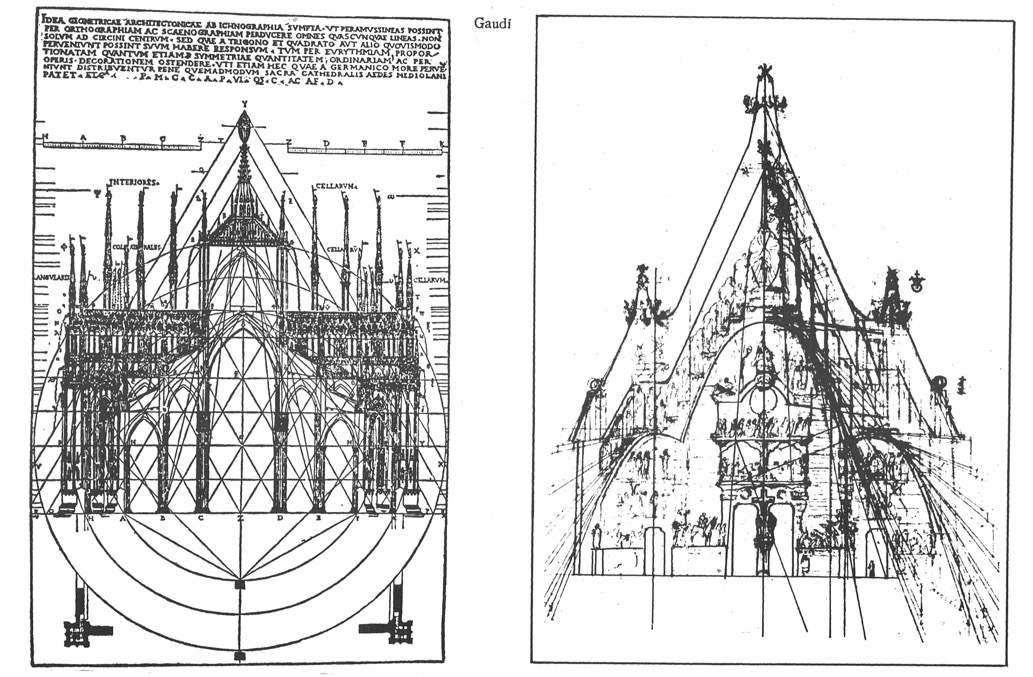
What we see above is on the left the analysis of Caesare Cesariano of the cross-section through Milan Cathedral. The idea is that the cathedral was built according to a Masonic system 'Ad Triangulum', a mystical geometry that is said to have also been adopted by Gaudí. On the right we have a drawing from Gaudí said to show an identical system of 'sacred geometry' as used in Milan, just adapted to his new construction.
As far I'm concerned Gaudí did managed to mix geometry, structural engineering and religious symbolism into La Sagrada Família. However, there is today a desire to attribute a religious motivation to Gaudí and his work. But the reality is that in his writings there is little mention of religion (or freemasonry), and second those who knew him said he was egocentric, prideful and bad-tempered (not particularly religious attributes).
I don't give much credence to these stores, but I do understand those who claim that in rushing to complete the basilica the originality of Gaudí is being swamped. But I would not go so far as to suggest that what we are looking at is something from a Batman film.